

Volume89 Numbe r2 March 2023 To Zoom or Not to Zoom. Dental Educators Want to Know the new york state dental journal Inside: One Safe Standard of Care for All
Is There a Way Out of The Workforce Morass?
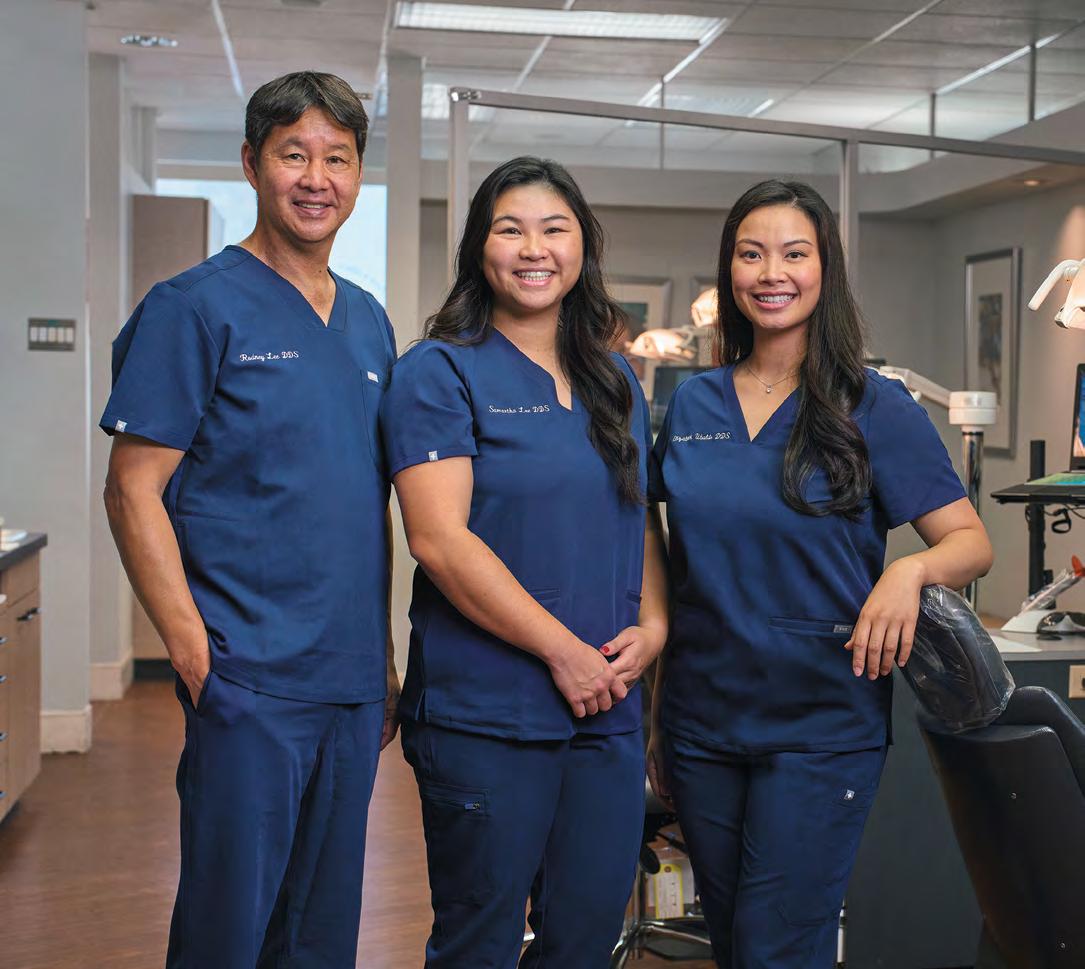
Cover:
16 Navigating Today’s Workforce Challenge
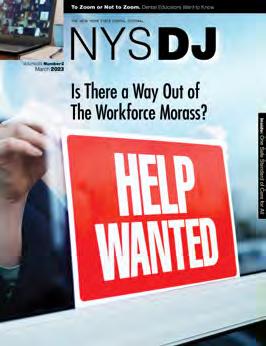
Betsy Bray, R.D.H., B.S. Search is on for short-term solutions to persistent problem of understaffed dental offices.

20 Students’ Perceptions of Teaching Methods for First-Year Dental Students during COVID-19
Ellen Lee, D.D.S.; Jungwon Roh; Aspen Wang; Aaron Bai, D.D.S.; Huan-yu Chen, D.D.S. Study undertaken to determine how student discern retention, understanding and learning of didactic and preclinical hands-on lectures.
24 Platelet-derived Material for the Treatment of Infrabony Periodontal Defects A Systematic Review and Meta-analysis
Armando Uribe-Rivera, D.D.S., M.S.; Daniel Heffes, D.D.S.; Hans Malmström, D.D.S.; Dongmei Li, Ph.D.; Yan-Fang Ren, D.D.S., Ph.D., M.P.H. Research comparing clinical outcomes of platelet-derived biomaterials, plateletrich plasma and platelet-rich fibrin for treatment of periodontal infrabony defects favored biomaterials.
Volume89 Numbe r2 March 2023 the new york state dental journal 2 Editorial A properly trained workforce 6 Attorney on Law The changing legal landscape 10 Association Activities 35 Component News 48 Classifieds 49 Index to Advertisers 52 Addendum
There are
you can take now to
your workforce.
policies
York State
Association
The New York State Dental Journal. EZ-Flip version of The NYSDJ is available at www. nysdental.org and can be downloaded to mobile devices. Use your smartphone to scan this QR Code and access the current online version of The New York State Dental Journal.
Is anyone answering your call for help?
steps
bolster
The New York State Dental Journal is a peer reviewed publication. Opinions expressed by the authors of material included in The New York State Dental Journal do not necessarily represent the
of the New
Dental
or
The Great Abdication
Healthcare stakeholders abdicate their duty to provide quality general and oral healthcare to all populations when they fail to uptrain members of the general and oral healthcare workforce to meet accredited standards for the services rendered.
Policymakers take the easy, but inequitable and dangerous, way out when they attempt to quick fix general and oral healthcare access-to-care challenges with lesser trained providers. Regrettably, such a policy will, in the near future, discriminate against the ever-expanding number of aging, medically compromised patients if healthcare fails to uptrain and legally expand general dentists’ scope of practice to help meet this population’s growing medical and dental needs.
Undertraining further prejudices the underserved, low-income and minority groups when the system directs these individuals to receive treatment formerly restricted to licensed dentists from lesser trained non-dentist providers. State legislators and licensing agencies, professional associations, and dental and medical academia must work together to uptrain the future oral healthcare workforce with the competencies necessary to provide access to the same level of quality general and oral healthcare for all populations.
General Dentists
Current epidemiologic trends and cutting-edge medical diagnostic and treatment options have given rise to an increase in an aged, chronically diseased and pharmacologically compromised population. While general dentists, at this time, do an excellent job meeting this group’s growing needs, future access to an increasingly complex level of care will require dentists with enhanced medical training and an expanded scope of practice that permits medical
management of a wider range of diseases related to the orofacial complex.
In addition, dentists could administer vaccinations, point-of-care diagnostic testing, medical counseling for systemic diseases, and basic screening and preventive services for chronic diseases, such as hypertension, diabetes and obesity, to improve access. Dental education does include comprehensive exposure to the basic sciences, but does not provide graduate dentists with the same accredited competencies in biomedical sciences and clinical medicine that physicians achieve.
The proliferation of medically complex patients in need of more focused care is reaching crisis levels, and over 80 million people in the U.S. live in primary care health professional shortage areas. Healthcare must uptrain dentists with medical competencies commensurate with physicians to increase this population’s access to the appropriate medical standard of care.
General dentist uptraining to more of an “oral physician” will require removal of barriers on three fronts. First, expand states’ scope-of-practice laws to allow dentists to act as a primary caregiver in an increased orofacial region and directly in the care of medically compromised patients. The move to this enhanced form of dental practitioner signals a natural progression, since the current legal scope and standard of care already requires that dentists diagnose and manage the oral symptoms and signs of systemic diseases and discover and manage systemic symptoms and signs of oral disease.
editorial 2 MARCH 2023 The New York State Dental Journal
Second, train dentists in the biomedical sciences exclusively in the same programs as physicians. Only with closely integrated dental and medical education can dentists receive the same foundation in clinical medicine and meet the same accreditation competencies as physicians. Combining programs will also reduce total education costs and better educate physicians on the import of oral health as part of general health.
Practically, dental education can only accomplish this uptraining with the support of our medical colleagues. Dentists can competently relieve physicians of a significant part of the burden of treating this medically compromised population and make physicians more available to meet other primary healthcare shortages. Together, the two professions must agree upon boundaries that both reduce access disparities and avoid professional turf battles.
Third, coordinate medical and dental benefit insurances to recognize and fairly compensate dentists for services traditionally linked exclusively to medical providers. Since medical insurance coding differs significantly from dental coding, dental curricula must train graduates to successfully submit and receive payment for medical claims.
Auxiliaries
General dentists can gain the time to incorporate enhanced duties as oral physicians into current general practices if nondentist or midlevel providers (MLP) perform some of the preventive and simple restorative and surgical procedures previously limited to licensed dentists. However, to maintain the standard of care, protect patients from injury and equitably offer the same quality of care to all populations, dentistry must either uptrain MLPs that operate without the direct supervision of a licensed dentist to the same Commission on Dental Accreditation (CODA) competencies as licensed dentists for the specific procedures performed or require direct dentist supervision of lesser trained MLPs.
Dental school requires a CODA-approved, four-year D.D.S. curriculum centered around biologic principles and diagnostic skills after a four-year college experience. Conversely, MLP programs, such as the curriculum for the dental health therapist in Alaska, requires only two years of training after high school. Significantly, no CODA-approved provider program exists for MLPs in the United States. Hence, when we train nondentist providers with less education and experience to perform the same procedures as licensed dentists, we create an unacceptable two-tiered standard of care.
No evidence indicates MLPs possess competencies comparable to dentists in areas of diagnosis, treatment planning, pathology, pharmacology, trauma care, special needs, behavioral management or management of other treatment complications. MLPs can achieve a level of technical quality in restorative procedures comparable to licensed dentists according to some studies. Other studies find that patients report similar acceptance satisfaction with treatment from non-dentist providers as from dentists. However, these conclusions merely indicate that MLPs know technically “how” to provide certain services, but do not possess the clinical judgment to know “when” or
EDITOR
Chester J. Gary, D.D.S., J.D.
MANAGING EDITOR
Mary Grates Stoll
ADVERTISING MANAGER
Jeanne DeGuire
ART DIRECTOR
Ed Stevens
EDITORIAL REVIEW BOARD
Frank C. Barnashuk, DDS. Clinical Assistant Professor, Department of Restorative Dentistry, School of Dental Medicine, University at Buffalo, The State University of New York, Buffalo, NY.
David A. Behrman, DMD. Chief, Division Dentistry/OMS, Associate Professor of Surgery, New York Presbyterian Hospital, Weill Cornell Medicine, New York, NY.
Michael R. Breault, DDS. Periodontic/Implantology Private Practice. Schenectady, NY.
Alexander J. Corsair, DMD. Periodontic/Implantology Private Practice. Rockville Centre, NY.
Joel M. Friedman, DDS. Associate Clinical Professor Dental Medicine. Columbia University College of Dental Medicine, New York, NY.
Jennifer Frustino, DDS, PhD. Director, Oral Cancer Screening and Diagnostics, Division Oral Oncology and Maxillofacial Prosthetics, Department of Dentistry, Erie County Medical Center, Buffalo, NY.
Michael F. Gengo, DDS. Board-certified Endodontist, Clinical Assistant Professor, Department of Endodontics, School of Dental Medicine, University at Buffalo, The State University of New York, Buffalo, NY.
G. Kirk Gleason, DDS. General Dental Practice, Clifton Park, NY.
Kevin Hanley, DDS. Orthodontic Private Practice, Buffalo, NY.

Violet Haraszthy, DMD, DDS, MS, PhD, Professor, Chair, Department of Restorative Dentistry, School of Dental Medicine, University at Buffalo, The State University of New York, Buffalo, NY.
Stanley M. Kerpel, DDS. Diplomate, American Board of Oral and Maxillofacial Pathology, Associate director, Oral Pathology Laboratory, Inc. Attending, section of Oral Pathology, New York Presbyterian, Queens, NY.
Elliott M. Moskowitz, DDS, MSD. Diplomate American Board Orthodontics; Clinical Professor. Department Orthodontics, NYU College Dentistry; Orthodontic Private Practice, New York, NY.
Eugene A. Pantera Jr., DDS. Past Director, Division of Endodontics, Department of Periodontics and Endodontics, School of Dental Medicine, University at Buffalo, The State University of New York, Buffalo, NY.
Robert M. Peskin, DDS. Dental Anesthesiology Private Practice. Garden City, NY.
Robert E. Schifferle, DDS, MMSc, PhD. Professor Periodontics, Endodontics and Oral Biology. School of Dental Medicine, University at Buffalo, The State University of New York, Buffalo, NY.
Jay Skolnick, DMD. Board-certified pediatric dentist. Attending dentist, Rochester General Hospital. Private practice, Webster, NY.
PRINTER
Fort Orange Press, Albany
NYSDJ (ISSN 0028-7571) appears three times a year in print: January, March and June/ July. The April, August/September and November issues are available online only at www. nysdental.org. The Journal is a publication of the New York State Dental Association, 20 Corporate Woods Boulevard, Suite 602, Albany, NY 12211. In February, May, October and December, members have online access to the NYSDA News. Subscription rates $25 per year to the members of the New York State Dental Association; rates for nonmembers: $75 per year or $12 per issue, U.S. and Canada; $135 per year foreign or $22 per issue. Editorial and advertising offices are at Suite 602, 20 Corporate Woods Boulevard, Albany, NY 12211. Telephone (518) 465-0044. Fax (518) 465-3219. E-mail info@nysdental.org. Website www.nysdental.org. Microform and article copies are available through National Archive Publishing Co., 300 N. Zeebe Rd., Ann Arbor, MI 48106-1346.
THE NEW YORK STATE DENTAL JOURNAL
The New York State Dental Journal ● MARCH 2023 3
“whether” to perform them. As such, MLPs not trained to CODA standards should only operate under the direct personal supervision of a licensed dentist.
Cost-effectiveness dictates oral healthcare utilize the least expensive team member qualified to perform a procedure to deliver that procedure. Allowing MLPs trained to competencies below CODA standards to operate without direct dental supervision unjustly risks patient injury and, thereby, discriminates against the recipients of the care. Conversely, unnecessarily mandating adherence to higher standards when lesser qualified auxiliaries could perform the same function at the same level of quality serves only to protect dentists’ turf out of self-interest at the risk of hindering access.
Oral healthcare must strike the correct balance, between patient safety and equity on one hand and access to an acceptable standard of care on the other, to maintain society’s trust in the dental profession.
The Dental Home
The dental workforce, regardless of the various members’ level of training, can best deliver the same standard of quality care to all populations within a dental home model. The dental home establishes a continuing dentist-patient relationship that begins no later than at 12 months of age and involves ongoing comprehensive and coordinated care for life.
The dental home workforce ideally should consist of an uptrained D.D.S./D.M.D.-degreed oral physician directing the course of care. MLPs trained to less than CODA standards, dental hygienists and dental assistants would function under the direct personal supervision of the dentist. Outside the dental home, MLPs trained to commensurate CODA standards could practice more independently in underserved areas. Allied oral healthcare personnel, such as community dental health coordinators, can provide education and coordination of oral health services to improve oral health literacy and address the needs of underserved populations.
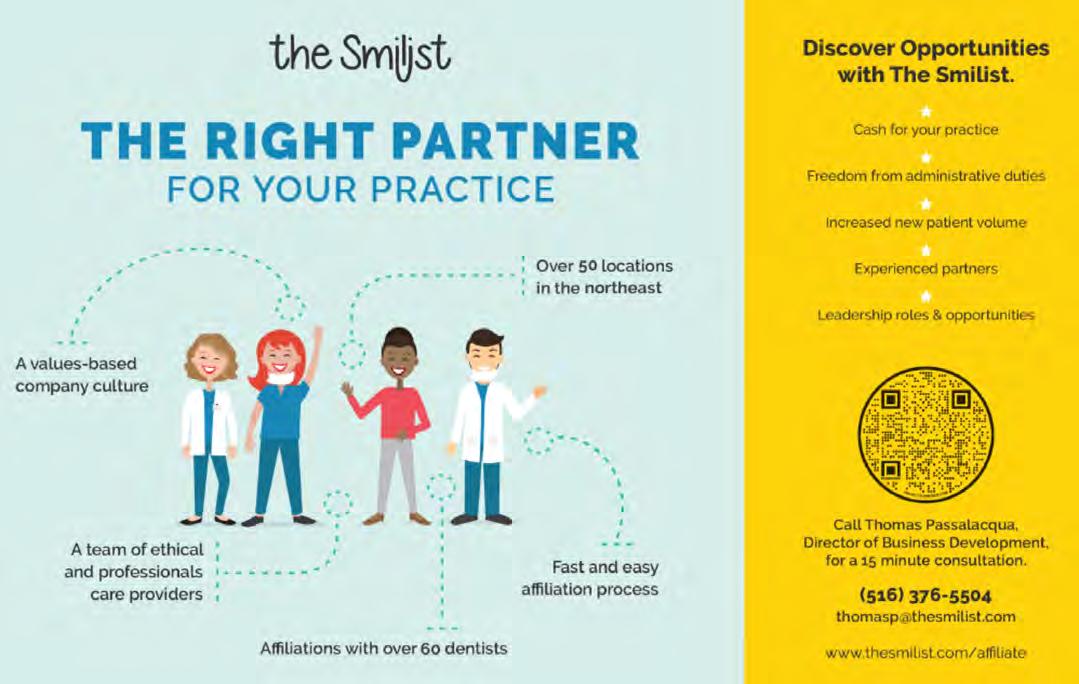
4 MARCH 2023 The New York State Dental Journal
Conclusion





Society, together with the healthcare professions, created accredited educational standards and licensing laws to ensure the delivery of one safe standard of care to all patients. Healthcare policymakers abdicate their duty to provide access to this minimum level of care to all populations when they fail to uptrain all licensed healthcare professionals to accredited standards for the specific care they deliver. This “Great Abdication” will risk patient injury, create two-tiered standards of care that discriminate against underserved populations and, ultimately, erode society’s trust in the health professions. Dentistry must field a future workforce trained to meet accredited standards to treat all members of our society safely and equitably.
Missing the Forest for the Trees
Great editorial by Dr. Gary in January Journal (“Dentistry’s Report Card”). Recruiting more members to organized dentistry is a prudent and enviable goal, as are activism and ethical thinking on the part of dental students. However, I have, unfortunately, witnessed new dental graduates fall short of actually providing the “trade” requirements of our field. Many can talk about a future fantasy land full of access to care and service to the community, but can’t fabricate a simple denture! Let’s not go the route of pharmacy (I used to be a pharmacist) and have a disconnect between education and retail reality.

 D.D.S., J.D.
D.D.S., J.D.
Make HIPAA Compliance the Easiest Part of Running Your Practice

 Nicholas Zacharczenko, D.D.S., M.S.D., R.Ph. Cooperstown
Nicholas Zacharczenko, D.D.S., M.S.D., R.Ph. Cooperstown

Trying to maintain HIPAA compliance on your own, typically requires more than 80+ hours a year, and can be daunting. Using a software solution that automates your HIPAA program can help practices generate & document mandatory HIPAA items such as the Security Risk Analyses, HIPAA training for doctors and staff, Business Associate Agreements, and other required policies & procedures.



Abyde is the NYSDA-endorsed software solution to help members with HIPAA compliance without the associated stress. They can help you adhere to all the requirements of each part of the HIPAA rules and regulations to make sure your organization is ready to pass a HIPAA audit.






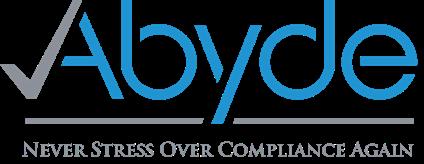
Wondering how your practice stacks up against the latest HIPAA requirements? Find out more about Abyde by calling 800.594.0883 x1 or visit the NYSDA website at www.nysdental.org
For more information about this and other Endorsed Programs call: 800-255-2100



•
* When enlarging or reducing this logo, always make sure to select Scale Strokes & E ects to maintain the integrity of the gradients in the core graphic. Main Logo on White Background Vertical Logos on Reversed-out Main Logo on Charcoal Background (with drop shadow behind-right of core graphic) Main Logo on Carbon Fiber Background (with drop shadow behind-right of core graphic) Reversed-out Main Logo on Carbon Fiber Background The New York State Dental Journal ● MARCH 2023 5
letters
Caring for Your Employees
As if a tight, competitive market didn’t give dentists enough employment woes, a rapidly changing legal landscape is adding more complexity.
Lance Plunkett, J.D., LL.M.
Dental hygienists and dental assistants (both licensed and unlicensed assistants) are often the majority of the employees in a dental practice. As such, employment laws are a major issue for this healthcare workforce. The fact that the employment law environment in New York State is rapidly changing for them, makes it imperative that their employers keep abreast of their legal obligations. Let’s start by looking at two quite remarkable proposed employment law developments.
The first comes from New York City. New York has always been an old-fashioned, “at will” employment law state. This means that employees serve at the will of the employer and can be terminated for any reason, including no reason at all, except for one that is illegally discriminatory. It also means that employees can quit employment at any time they wish. However, the New York City Council is considering legislation—Bill No. 837—that would end at-will employment and turn New York City into a “wrongful discharge” jurisdiction. As the bill summary notes:
“This proposed bill would prohibit employers from terminating employees without just cause. It would also prohibit, with enumerated exceptions, the use of electronic monitoring in discharging or disciplining employees.”
In a wrongful discharge jurisdiction, an employer’s ability to terminate an employee is more limited and can be challenged by the employee if the employer has not taken valid action to terminate the employee. It puts more of a burden on the employer to justify the termination than
a pure at-will employment jurisdiction would— and, therefore, presages more employment litigation over improper terminations.
If New York City adopts its wrongful discharge legislation, it would change over 200 years of law in New York State. It would certainly limit flexibility for dental employers in a tight workforce market for dental hygienists and all types of dental assistants. We won’t know how the New York City Council will vote on this issue or whether Mayor Eric Adams will sign it into law until after this Journal issue goes to print, but NYSDA will be watching it closely.
The End of Non-Compete Agreements?
The second development comes from the Federal Trade Commission (FTC). The FTC has proposed sweeping regulations under its authority to define unfair competitive practices pursuant to Section 5 of the Federal Trade Commission Act to prohibit using covenants not to compete (non-compete agreements) and retroactively canceling existing non-compete agreements. The breadth of these proposed FTC regulations is extraordinary. They would preempt state laws to the contrary and would apply to all employers and to all pay levels for employees and independent contractors, including dentists and their employees and independent contractors. While it tracks what California law already does (as well as law in North Dakota and Oklahoma), it would be a vast change for New York State (and all of the other 46 states—although some states have adopted non-compete restrictions for certain low-wage employees).
ATTORNEY ON LAW
6 MARCH 2023 The New York State Dental Journal
New York was the seminal state for honoring non-compete agreements in a famous court case involving dentists and decided by the New York State Court of Appeals in 1971— Karpinski v. Ingrasci (see The NYSDJ from December 1994 explaining New York law subsequent to this case). While New York has more recently floated ideas about legislation aimed at limiting non-compete agreements, the bulk of those discussions have been centered around low-wage earners (and some dental assistants might well fall into that category). In addition, the New York State Attorney General has taken action against several companies for abuse of non-compete agreements, again focusing on low-wage earners. However, no actions in New York remotely parallel the sweeping FTC regulatory proposal.
The FTC proposal creates only one exception in the context of sales of businesses, where purchasers of businesses can enter into non-compete agreements with owners selling the businesses. While that exception might be useful for dental practice sales between two dentists, it would not help dental practice employers in the hiring of employees or independent contractors, including hiring dentists, dental hygienists or dental assistants.
The FTC is in the process of gathering public comments on its proposal, and those comments may help to narrow the scope of the proposed regulations. In particular, the FTC has been interested in comments related to whether earnings of employees should be a factor in applying the prohibition on non-compete agreements and/or whether it should apply to executive level personnel.
The FTC is also interested in hearing comments on the retroactive rescission of existing non-compete agreements— a feature of the regulatory proposal that is drawing much legal attention as to whether the FTC even has the authority under the United States Constitution to enact such a sweeping regulatory prohibition. This is another issue whose fate will not be known as this Journal goes to print, but it will also be watched closely by NYSDA.
Given the controversy brewing over this proposal, it may well have been a strategy of the FTC to make a pitch for a giant change of law in order to at least end up with a more reasonable change of law. Keep in mind that California is the model for the FTC proposal and that, too, will likely be a factor in where this proposal ends up. Also, in a recent FTC public comment forum held in February, it was remarkable that medical groups were among the biggest supporters of the FTC proposal, frequently arguing that it would help healthcare providers against private investment interests that were interfering with health care. Antitrust law can make strange bedfellows.
NYSDA Directory
OFFICERS
James E. Galati, President 1758 Route 9, Halfmoon, NY 12065
Anthony M. Cuomo, President-Elect 667 Stoneleigh Ave., Ste 301, Carmel, NY 10512
Prabha Krishnan, Vice President 11045 Queens Blvd., Ste 108, Forest Hills, NY 11375
Frank C. Barnashuk, Secretar y-Treasurer 3435 Main St., UB School of Dental Medicine, Buffalo, NY 14214
Steven Gounardes, Speaker of the House 133 70th St., Brooklyn, NY 11209
BOARD OF TRUSTEES
Kevin A. Henner, Immediate Past President 163 Half Hollow Rd., Ste 1, Deer Park, NY 11729
Brendan P. Dowd, ADA Trustee 3435 Main St., UB School of Dental Medicine, Buffalo, NY 14214 NY – Maurice L. Edwards 30 East 60th St., Ste 401, New York, NY 10022
2 – John P. Demas 8814 Fort Hamilton Pkwy, Brooklyn, NY 11209
3 – Steven L. Essig Emblem Health, 1873 Western Ave., Albany, NY 12203
4 – Wayne S. Harrison 8 Medical Arts Ln., Saratoga Springs, NY 12866
5 – Margaret Madonian 600 Oswego St., Ste B., Liverpool, NY 13088
6 – Luis T. Mauleon 501 N. Cayuga St., Ithaca, NY 14850
7 – Theresa A. Casper-Klock 33 William St., Ste 1, Auburn, NY 13021
8 – Raymond G. Miller 1965 Como Park Blvd., Lancaster, NY 14086
9 – Gary M. Scharoff 1255 North Ave., Ste A1H, New Rochelle, NY 10804
N – Frank J. Palmaccio 875 Old Country Rd., Ste 101, Plainview, NY 11803
Q – Viren L. Jhaveri 14031 Cherr y Ave., Apt. 18, Flushing, NY 11355
S – Guenter J. Jonke 2500 Nesconset Hwy., Bldg 24A, Stony Brook, NY 11790
B – Amarilis Jacobo 824 E. 181st St., Bronx, NY 10460
COUNCIL CHAIRPERSONS
Council on Awards
Dental Benefit Programs
Dental Education & Licensure
Dental Health Planning & Hospital
Dental Practice
Ethics
Governmental Affairs
Membership & Communications
Nominations
Peer Review & Quality Assurance
Professional Liability Insurance
OFFICE
Richard Andolina
74 Main St., Crossroad Professional Building Hornell, NY 14843
Patricia M. Hanlon
4 Lyme St., Wading River, NY 11792
Joseph Gambacorta
8 Grosvenor Rd., Buffalo, NY 14223
Dentistry
Sean McLaren
522 E Moreno Dr., Rochester, NY 14626
Lois A. Jackson
505 Laguardia Pl., Apt L4, New York, NY 10012
Nick J. Vittoria
859 Connetquot Ave., Ste 1, Islip Terrace, NY 11752
Robert F. Schaefer
110A W. Utica St., Oswego, NY 13126
Claudia Mahon-Vazquez
18 Biltmore Dr., Shoreham, NY 11786
Kevin A. Henner
163 Half Hollow Rd., Ste 1, Deer Park, NY 11729
Barry Sporer 80 Park Ave., Ste 1C, New York, NY 10016
David J. Reed
1998 Empire Blvd., Webster, NY 14580
Suite 602, 20 Corporate Woods Blvd., Albany, NY 12211 (518) 465-0044 | (800) 255-2100
Gregory D. Hill
Lance R. Plunkett
Michael J. Herrmann
Grazia A. Yaeger
Mary Grates Stoll
Jenna Bell
Betsy Bray
Briana McNamee
Stacy McIlduff
Executive Director
General Counsel
Assistant Executive Director Finance and Administration
Assistant Executive Director Marketing and Communications
Managing Editor
Director of Meeting Planning
Director of Health Affairs
Director Governmental Affairs
Executive Director NYS Dental Foundation
The New York State Dental Journal ● MARCH 2023 7
New Laws Keep Coming
What about New York employment items that are already law? We covered quite a few in the November and January Journals, but late December saw even more items enacted that will affect how dental practices deal with their employees. Those items include all the following laws.
New York State Pay Transparency Law
New York State enacted a pay transparency law as Chapter 723 of the Laws of 2022 (New York City and Westchester County already had their own local laws on this). The law takes effect statewide on Sept. 17. It amends the New York Labor Law by creating a new Section 194-b that requires all private sector New York employers with four or more employees to list compensation ranges in job advertisements or postings for all positions to be performed, at least in part, in New York State. The law applies to advertisements for jobs, promotions or transfer opportunities. Advertisements for jobs, promotions or transfer opportunities paid solely on commission must disclose generally that compensation is based on commission, but not the commission formula.
The law also requires that employers post a job description for a position if such a job description exists. The law further requires that employers keep records to show compliance with the law, including, but not limited to, “the history of compensation ranges for each job, promotion, or transfer opportunity and the job descriptions for such positions, if such descriptions exist.”
It should be noted that in February. the Legislature passed amendments to the law that would eliminate this recordkeeping requirement, but the legislation has not yet been sent to the governor for action as of the writing of this article. It was expected the governor would sign these amendments into law, as she had indicated the law needed amendments in order not to be excessively burdensome for employers. However, relations between the governor and the Legislature cannot be described as a love fest right now.
Expanded New York Paid Family Leave Law
Quite some time ago, New York State also amended its Paid Family Leave Law in Chapter 550 of the Laws of 2021 to expand the definition of a family member to include siblings with a serious health condition. This includes biological siblings, adopted siblings, stepsiblings and half-siblings. The law took effect Jan. 1, over a year after it had passed.
Protection Against Lawful Absences from Work
Gov. Hochul signed into law, as Chapter 604 of the Laws of 2022, amendments to Section 215 of the New York State Labor Law that protect employees who take legally protected time off from work from retaliation, discrimination or discipline. The law protects absences from work protected by federal, state or local law,
and took effect on Feb. 19. While this seems like simple common sense, it makes it difficult for employers who used a “nofault” work attendance policy. A “no-fault” attendance policy is one that assesses points, demerits or penalties for absences or tardiness regardless of the reason. That type of policy would now clearly violate Section 215 of the Labor Law and would need to be either discontinued or rewritten to adapt to the newly revised Section 215.
Workplace Posters
Gov. Hochul signed into law, as Chapter 693 of the Laws of 2022, amendments to Section 201 of the New York State Labor Law requiring employers to provide electronic copies of mandatory workplace postings to employees. Employers must also provide notice to employees that documents that are required to be posted physically are also available electronically. The electronic posting requirement took effect on Dec. 16. Employers are also still required to continue posting physical copies of all required posters and other documents in conspicuous locations on each floor of their workplaces. Failure to comply with the electronic and physical posting requirements could result in monetary fines and penalties, the amounts of which vary based upon the posting or document the employer failed to post.
Nursing Mothers’ Breastmilk Expression
Gov. Hochul signed into law, as Chapter 672 of the Laws of 2022, to take effect on June 7, a requirement that all employers in New York State provide nursing employees reasonable break time to express breastmilk at work for up to three years following childbirth. Upon request of a lactating employee, employers must designate a room or other location to express breastmilk. Such location must be close to the work area, well lit, shielded from view and free from intrusion. Absent undue hardship on the employer due to significant difficulty or expense, the room or location must also have a chair, a working surface, nearby access to clean running water and an electrical outlet. The room or location provided by the employer cannot be a restroom or toilet stall.
Employers also must provide a written policy on breastmilk expression developed by the New York State Department of Labor to employees upon hire and annually thereafter, as well as to employees who return to work after childbirth.
New York State Vaccination Leave Law
Gov. Hochul signed into law, as Chapter 234 of the Laws of 2022, legislation extending paid novel coronavirus (COVID-19) vaccination leave under Section 196-c of the New York State Labor Law for another year, through Dec. 31, 2023. The law requires employers to provide employees with a “sufficient period of time, not to exceed four hours” for each COVID-19 vaccination and booster dose. Employees must be paid at their regular rate of pay for their leave time.
8 MARCH 2023 The New York State Dental Journal
The vaccination leave cannot be charged against any other leave to which the employee is entitled, including paid sick leave.
All employees working in New York State are eligible to take such leave. Employers should update their policies and inform their employees responsible for managing employee leave of the law’s extension through the end of 2023. The completely separate New York State Paid COVID-19 Sick Leave Law also remains in effect.
New York State Sexual Harassment Hotline
Gov. Hochul signed into law Chapter 138 of the Laws of 2022 that amended the New York State Human Rights Law (Section 296 of the New York State Executive Law) to require the establishment of a toll-free, statewide, confidential hotline for reporting workplace sexual harassment complaints. The hotline number is (800) 4272773 (800-HARASS-3) and was launched on July 19, 2022. The hotline is managed by the New York State Division of Human Rights, operates during normal business hours, and is staffed by a team of pro bono attorneys who can also give callers legal advice. Employers should update their sexual harassment materials and policies provided to employees to include information about the new hotline.
Veterans’ Benefits and Services Poster
Although this item would affect very few dental practices, it’s worth mentioning that Gov. Hochul signed into law, as Chapter 584 of the Laws of 2022, a requirement that all employers with more than 50 full-time employees conspicuously display a Veterans’ Benefits and Services Poster. The law took effect Jan. 1. While not many dental practices have more than 50 employees, the poster is free and can be downloaded and printed from the New York State Department of Labor website. This makes it a nice thing to do to support veterans even if not required for smaller dental offices—and it is probably one of the better regulatory wallpaper items.
New York City Artificial Intelligence (AI) Automated Employment Decisions Tool Law
Finally, New York City has postponed enforcement of New York Local Law Int. 2021/144 (which makes it unlawful for New York City employers to use AI automated employment decision tools to screen job candidates for jobs or promotions unless the employer conducts an independent bias audit). New York City held extensive public hearings on the law and concluded that although it was slated to take effect on Jan. 1, that effective date needed to be postponed until April 15. There was mass employer confusion over what constituted an acceptable AI bias audit and how it should be conducted. As one legal wag put it, “What if there is bias in the AI bias audit?”
Stay Tuned for More
2023 will likely see more employment law developments in New York State. It is the fastest changing field of law in New York right now. All of this complicates the ability to hire and retain dental hygienists, dental assistants and all other employees in a very tight, competitive job market. Many of these new laws expand worker opportunities and rights, giving them an advantage in seeking out varying job opportunities. This lends added urgency to NYSDA’s own efforts to make improving the employment landscape for dental offices a top priority. This employment landscape will bear constant watching lest it turn into an employment desert for dental practices. p
The material contained in this column is informational only and does not constitute legal advice. For specific questions, dentists should contact their own attorney.
Chautauqua Dental Congress
June 29 - 30, 2023
New schedule! Thur AM & PM and Fri AM New venue! Chautauqua Harbor Hotel
Thursday morning June 29
Oral Surgery in General Practice, Dr. David Todd Case Based Approach to Oral Surgery Complications
Dr. Kevin Lee
Thursday afternoon June 29
Saving Teeth - Perio Role in Team Approach to Complex Multidisciplinary Cases
Dr. Anna Paritsky
Friday morning June 30
One Day Jaw Rehabilitation for the Head/Neck Cancer
Patient: Prosthetic & Surgical Considerations
Drs. Mike Markiewicz & Vladimir Frias
Lectures Thur 9am-12pm & 1-4pm / Fri 9am-12pm
CE Credit Hrs: 12 ADA/CERP
Dentist $225 / Team Member $125
The Sebastian G. Ciancio
The New York State Dental Journal ● MARCH 2023 9
NYSDF Selects Fundraising Professional For Top Staff Position
STACY MCILDUFF, A CERTIFIED FUNDRAISING EXECUTIVE, is the new executive director of the New York State Dental Foundation. Ms. McIlduff, who assumed the position in February, was employed most recently as vice president of development and external affairs for the Schenectady County Community College (SUNY Schenectady) Foundation. As a member of the college President’s Cabinet, she created a strategic plan for the foundation and was the key person involved with significant fundraising for the college.
Ms. MclIduff had been with SUNY Schenectady since 2015 and previously served as the college’s coordinator and then executive director of development. Prior to that, she was employed as annual giving officer for Equinox, Inc., an Albany-based human services organization, and as manager of annual programs for Seton Health Foundation, Inc., in Troy.
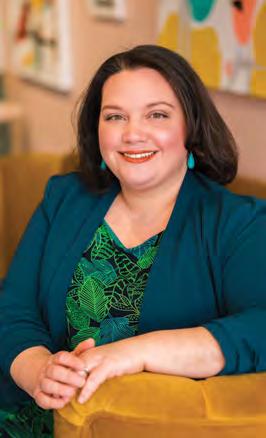
In addition to her extensive experience in fundraising and grant writing, Ms. McIlduff is adept at graphic design, digital media and video production. She holds a Bachelor of Arts degree in interdisciplinary studies, with a concentration in event design and production, from SUNY Empire State College, and an Associate degree in fine arts from Fulton-Montgomery Community College. She received a certificate in television production from the New School of Radio and Television.
NYSDA Announces Winners of its Highest Awards
THE NYSDA COUNCIL ON AWARDS has announced its candidates for the Association’s top honors. All of the nominees were approved by the NYSDA Board of Trustees and will receive their awards at the Annual House Meeting in June.
They are: Dr. Mary Kang, Jarvie-Burkhart Award; and Dr. William Calnon and Dr. James Orcutt, Dr. Mark J. Feldman Distinguished Service Award.
Dr. Kang, cross-trained in both prosthodontics and oral/ maxillofacial surgery, teaches complex prosthetics at the Ashman Department of Periodontology and Implant Dentistry at NYU. She created the interprofessional project at NYU College of Dentistry and Nursing, requiring that every patient be evaluated thoroughly for overall health. She currently has a grant from the National Institute of Dental and Craniofacial Research to improve the oral health of vulnerable pregnant women by increasing dental care utilization.
Dr. Kang is also working on a project with biomimetic dentistry, testing her theory that the life cycle of teeth can be preserved with tertiary prevention. And she created the framework for overdentures and obturators.
Dr. Calnon has committed over 40 years to NYSDA and has been involved at all levels of organized dentistry. He served as president of Monroe County Dental Society, Seventh District Dental Society, NYSDA and the ADA; sat on numerous NYSDA councils; and has been active in EDPAC, the ADA Dental Foundation and other affiliated organizations.

He most recently headed the search committee for NYSDA’s new executive director, and helped run Dr. Paul Leary’s campaign for ADA President-Elect.
Dr. Orcutt has invested more than 50 years in organized dentistry, filling a number of leadership roles at the local, state and national levels, including president of the Dental Society the State of New York (now, NYSDA) and member of its Board of Governors, and delegate and alternate delegate to the ADA House. Among his accomplishments, Dr. Orcutt helped create a strategic plan for the organization and worked on legally expanding duties for dental assistants through changes to the New York State Dental Practice Act.
Association Activities 10 MARCH 2023 The New York State Dental Journal
Stacy McIlduff
William Calnon
Third District Names New Executive Director
THE THIRD DISTRICT DENTAL SOCIETY welcomed a new executive director in March following the retirement of Kathleen Moore, who held the ED post for 26 years. Paula A. Tancredi Penman of Saratoga Springs has joined the society, the latest stop in a career that encompasses positions in healthcare management, pharmaceutical marketing and nonprofit management. She was most recently employed as director of operations for the Fulton County YMCA.
Ms. Penman holds a BA degree in English literature and political science from Rutgers University and an MBA degree, with concentration in marketing and strategy, from Yale School of Management. She is an online course developer and faculty member, Excelsior University, Albany, and adjunct professor, Management and Business Department, Skidmore College, Saratoga Springs.
Stephen Burgart Receives Appointment to State Assistance Committee
AT ITS MEETING in early March, the New York State Board of Regents approved the appointment of Stephen Robert Burgart, D.D.S., of Honeoye Falls, Seventh District Dental Society, to the State Boards for the Professions Committee for Professional Assistance. Dr. Burgart’s appointment to the committee, which deals with licensed professionals with alcohol or substance abuse issues, is for five years.
Dr. Burgart, who is retired, is a member of the NYSDA Committee on Substance Abuse and Well-Being and a delegate to the NYSDA House.
NSS Board Approved
NOMINATIONS to the NYSDA Support Services Board have been approved by the NYSDA Board of Trustees. The following will serve in 2023:
Joseph Caruso, chairman; Michael Herrmann, president; Mark Weinberger, treasurer; Robert Doherty; Lawrence Volland; Minerva Patel; Roxene Gascoigne; Dimitrous Kilimitzoglou; Tricia Quartey-Sagaille; Mina Kim; and Mario Silvestri.
NYSDA Secretary-Treasurer Frank Barnashuk and Executive Director Greg Hill will serve as ex-officio members of the Board.
Accounting for Dentistry, C.P.A., P.C.
Purchasing a practice is one of the most consequential events of your professional career.
Before you commit, be sure to obtain an independent assessment of the opportunity.


For over twenty years we have been providing comprehensive projections of the financial results dentists can expect in considering the purchase of a dental practice. We have no material interest that compels us to approve the transaction.
Unlike your banker or broker, we are an independent CPA firm acting exclusively as your advocate to provide unbiased projection results. We also never advise both sides of the deal, avoiding any possible conflict of interest.
Contact Dr. Rothstein directly and confidentially to discuss any aspect of the due diligence analysis, multi-year projection of results, financing issues, closing process and/or accounting, payroll, tax, compliance and managerial issues relating to the initiation of operations as a new owner.
Association Activities We understand the business of dentistry. Providing services throughout New York and New England. www.doctorscpa.com drothstein@doctorscpa.com (518) 851-9016 Dan Rothstein, D.D.S., M.B.A., C.P.A. Member ADA, NYSDA, NYSSCPA and AICPA
ACCOUNTING, AUDIT, CONSULTING AND TAX SERVICES FOR THE DENTAL PROFESSION Accounting for Dentistry, C.P.A., P.C. is a CPA firm created by a dentist for dentists. ApprovedThankyou!
The New York State Dental Journal ● MARCH 2023 11
NEW YORK COUNTY
John Delfino
Temple University ‘67
15 Chieftans Road
Greenwich, CT 06831-3260




January 15, 2023
THIRD DISTRICT
Richard Bergman
New York University ‘72
11396 Ohanu Circle
Boynton Beach, FL 33437
February 6, 2023
FIFTH DISTRICT
Leonard Fishman
Temple University ‘56
2625 E Lake Road
Skaneateles, NY 13152
November 20, 2022
Xandria Sutherland-Pollard

New York University ‘90
7655 Oswego Road
Liverpool, NY 13090
February 26, 2023
SIXTH DISTRICT
Peter Hatala
Georgetown University ‘61
3401 Almar Drive
Vestal, NY 13850
February 24, 2023
NINTH DISTRICT
Vincent Commercio
University of Medicine New Jersey ‘68


40 Laurel Hill Road, #104

Brookfield, CT 06804
February 13, 2023
Association Activities © 2022 Henry Schein, Inc. No copying without permission. Not responsible for typographical errors. Your practice is one of your most important assets. DO YOU KNOW WHAT IT’S WORTH? While no one likes to think about it, things do happen and it’s always important to be prepared. Knowing your practice’s value can make the difference between selling your practice or having it become unsellable. That is why practice owners should have an up-to-date practice valuation. A Henry Schein Dental Practice Transitions valuation considers both tangible and intangible assets of the practice and can provide the many key factors which influence the practice’s value. To get started on your practice valuation or schedule a complimentary consultation, give us a call at 866-335-2947 www.henryscheindpt.com 866-335-2947 ■ PRACTICE SALES ■ VALUATIONS ■ TRANSITION CONSULTING/ PLANNING ■ ASSOCIATESHIPS 21PT4334_plans options worth_7x4.5_.indd 3 1/26/21 4:52 PM 12 MARCH 2023 The New York State Dental Journal
Memoriam
In

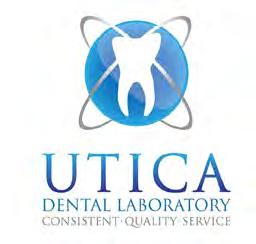
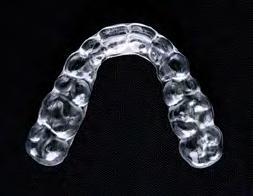
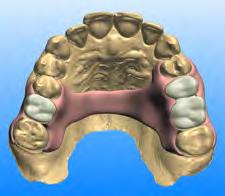
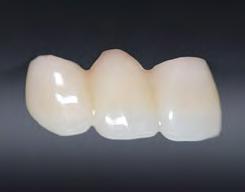
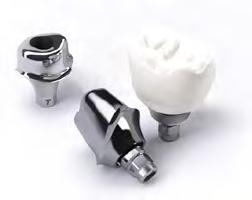

A Fusion of Modern Innovation with Traditional Dental Lab Concepts 3D Printed Nightguards Digital Design. 3D Print. Perfect Fit. Strong yet flexible. Easily replace worn, damaged, or lost splints with digital records. Precisely fabricated with traditional or digital impressions. Regular price $55 Discount price $39 UTICADENTALLAB.COM 866 733 3152 TCS 3D Flexible Partial TCS Flexible Partial Dentures Milled from a Puck. Same flexible material, New Method of manufacturing. The best fitting flexible partial Guaranteed! Milled Flexible Partial Base with 3D Printed Teeth. Regular price $209 Discount price $159 Crown & Bridge Choose either BruxZir® or IPS e.max® Prime Zirconia. Turnaround time 5 lab days. Most types of digital and traditional impressions accepted. Schedule an expedited case at no extra charge. $20 TruAbutment & Zirconia crown 8 In Lab Working days. Price includes all model work, titanium CAD/CAM custom TruAbutment, BruxZir® or IPS e.max® Prime Zirconia, and two screws. Regular price $299 Discount price $199 Send us your Digital Impressions Today! We Accept Scans for Both Fixed And Removable. Crowns regular price $79 Bridges regular price $89 OFF per unit
How Automated Dental Insurance Verification Helps with Staff Shortages
Robert McDermott
We’re still feeling the staffing effects of the seismic shift in the workforce due to the pandemic. From remote work options to the Great Resignation, no industry has managed to escape staffing shortages. For dental practices, it’s not only difficult finding staff, it also means hiring staff with limited experience who are learning on the job. That means experienced staff members are shouldering a big burden and, as practice managers, finding ways to provide manageable workloads while helping your dental practice grow is challenging. Thankfully, technology is stepping in and helping existing staff prioritize and practices flourish.
Dental Staffing Challenges
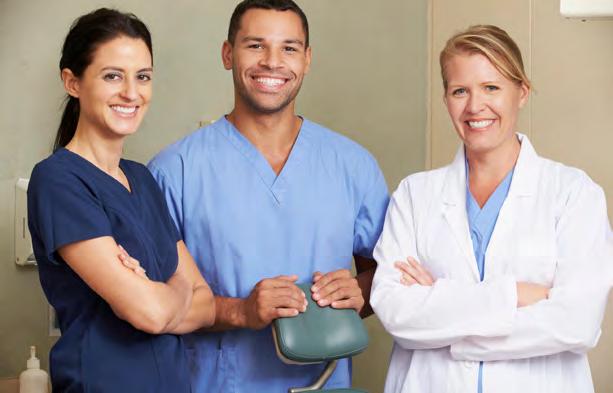
An ADA study found that nearly 70% of dentists report struggling to find and hire dental hygienists. For dental assistants, nearly 60% of dentists find hiring a challenge.
So what’s the real impact of staffing shortages? First and foremost, patient capacity is significantly impacted. You simply cannot see or care for as many patients without the staff to assist. In addition to patient care issues that arise from being short staffed, vital services and administrative tasks can also take a backseat to patient priorities. Unfortunately, for patient care, as well as practice efficiency and continuity, these tasks cannot be ignored.
In fact, one of the other significant reasons patients seek out a new provider is a failure to communicate, especially when it comes to billing and understanding what dental insurance covers and what expenses will be out-of-pocket. Recent research suggests that concerns about billing and costs are something patients would much rather discuss with their healthcare provider than, perhaps, insurance companies.
That means, for your practice, finding ways to maximize efficiency and automate business office responsibilities can help to mitigate staffing challenges and offer additional benefits, such as reducing overall administrative costs.
What is Automated Dental Insurance Verification?
One of the most time-consuming tasks your staff is required to
conduct and manage day after day is dental insurance verification. Given the importance of insurance verification to your patients and your ability to generate revenue, it’s a business-critical task, and one that cannot be reprioritized.
Automated dental insurance verification takes that task off staffs’ plates through an automated process. Automation not only verifies the dental insurance coverage for all of the patients on your schedule for the week, it does so much more in terms of ensuring your patients, and your practice, get the most out of their coverage.
How Automated Dental Insurance Verification Can Help You Overcome Dental Staffing Shortages
In addition to myriad other benefits, sophisticated yet simple automated dental insurance verification can save you a significant amount of time and allow you to reallocate resources to support your existing staff, your practice and your patients.
When conducting manual dental insurance verification, research suggests that every single verification takes a minimum of 12 minutes, and that’s if everything goes smoothly. Estimates suggest that, over the course of a week, handling insurance verifications, from initial checks and calls to clarifying issues, can take 20 to 30 hours a week. That’s almost a full-time employee and, again, that assumes there are no denials, no questions, no changes in plans or additional challenges that plague the dental insurance verification process.
In addition to alleviating the time and resources needed to complete the insurance verification process, you’re freeing up your staff to focus on other tasks, like scheduling, that can help keep your patients happy and returning.p
Mr. McDermott is president and CEO of iCoreConnect. NYSDA endorses iCoreVerify automated insurance verification software. iCoreVerify completes automated insurance verifications—up to seven days in advance—for every patient on the schedule. Book a demo to see how it can reduce your administrative costs and provide additional efficiency benefits: visit iCoreConnect.com/NY6; or call 888.810.7706. NYSDA members receive substantial discounts on iCoreVerify by iCoreConnect.
14 MARCH 2023 The New York State Dental Journal
Since 1996, our team of experts have provided successful transition services exclusively to dentists. Choice prides itself on its reputation for integrity, service and results for both traditional practice sales and commission-free sales to DSOs.

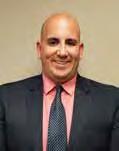
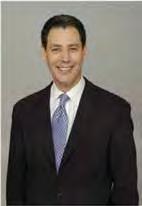

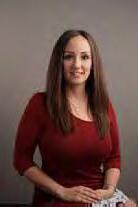
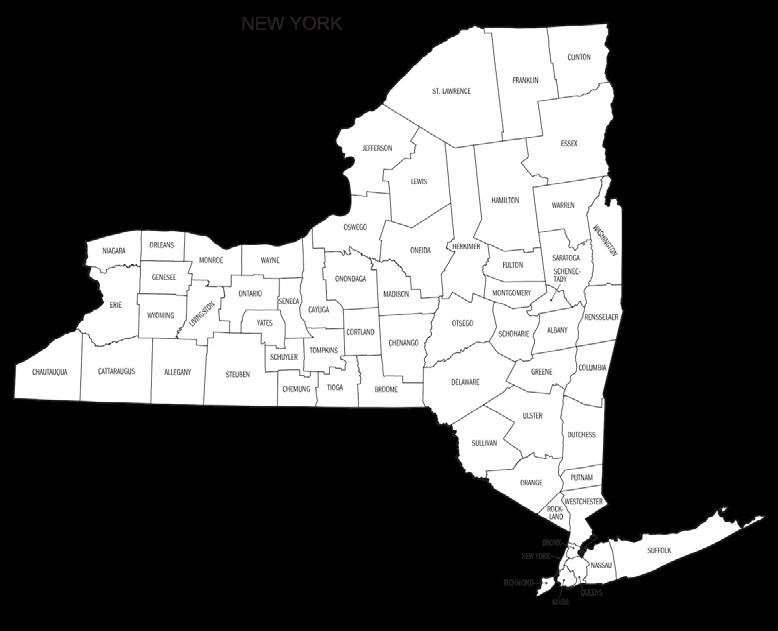
Navigating Today’s Workforce Challenge
If you are having difficulty staffing your dental office, you are not alone. Workforce challenges, namely, recruiting, hiring and retaining qualified and competent employees, are nearing crisis level in all areas of healthcare. The pandemic only exacerbated staffing disruptions and obstacles.

How will we build a sustainable future for dentistry? Understanding the current employment landscape will help us navigate the future. In the U.S. today, unemployment is at its lowest rate (3.4%) since 1964.1 According to labor trending, the percentage of full-time employees (ages 16 to 64) who worked year-round dipped from 52.9% to 50.5% between 2019 and 2021.2 At the same time, the Unites States Census reports that the number of people working from home has tripled in the last three years. These variables equate to fewer viable candidates to add to the dental workforce.
While we work to identify long-term solutions by evaluating education, licensing obstacles and industry disruptors, dentists need short-term solutions today.
When it comes to staff recruitment and retention, the game has gotten harder to play. We must learn how to discern both the priorities of candidates and our own challenges for adapting to healthcare’s changing landscape.
Once upon a time, offering another dollar an hour than the practice down the road seemed to do the trick. Attracting and retaining candidates in today’s market requires asking the right questions and listening to what motivates and satisfies them. According to the ADA Dental Workforce Shortages Report, 3.75%
of hygienists surveyed (5,122) voluntarily left the workforce in 2021.3 While we know roughly five percent left due to COVID safety concerns,4 a staggering 42.9% of those surveyed reported their reason for leaving the field was workplace culture.
Although many complex variables exist in care delivery today, the environment in which we work is something we can control. You may be asking, how do I know if I have a positive workplace culture? And what steps can I take to nurture one? According to industry experts, it comes down to four key factors: praise, a sense of challenge, the opportunity to grow and economic reward. 5 Creating an atmosphere that focuses on these key areas can reduce stress and lead to staffing stability. “The most misunderstood concept when hiring and retaining team members is that the formula will flip if the first three (praise, challenge, opportunity for growth) are not in balance” Majors (2022).
With no end to staffing shortages in the near future, it is important to work smarter, not harder. There are numerous technology products on the market to assist dentists to increase office efficiencies. These include online scheduling options, automated payment systems, incorporating teledentistry, and employment matching and credentialing.
Perhaps consider moving to a cloud-based practice management system. The latest software systems can streamline patient recordkeeping, insurance processing and help keep your files organized and accessible.
dental practice
Looking for short-term solutions to stem the tide of a vexing problem.
16 MARCH 2023 The New York State Dental Journal
Betsy Bray, R.D.H., B.S.
To learn more, I asked Dr. Chris Salerno, chief dental officer at Tend, his thoughts on the challenges of developing and maintaining the dental workforce today.

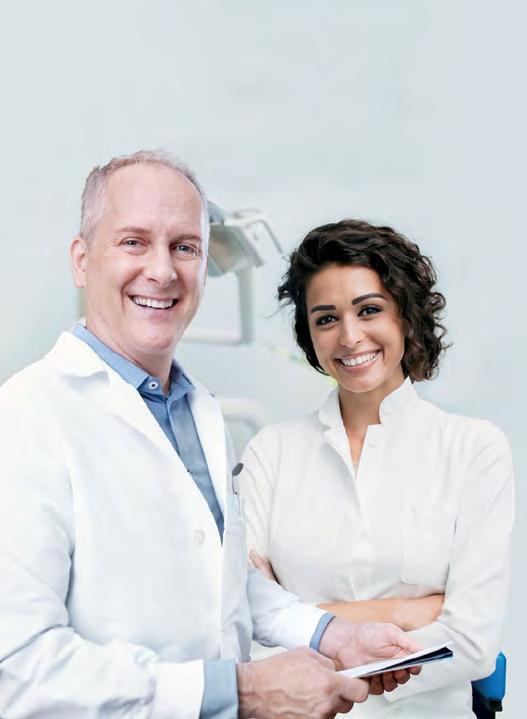
BB: From your perspective, what are the top industry disruptors changing dentistry today?
CS: The top industry disruptor, in my opinion, is the data revealing current supply and demand. Research from the ADA Healt h Policy Institute predicts that the supply of dentists will increase through 2040, while demand for our services is not increasing at the same rate.6 The second disruptor is dental practices’ profit margin squeeze, that is, rising costs that have been met with flat or even decreasing third-party payer reimbursements. The third disruptor is the workforce. While some hygienists and dent al assistants left the profession during COVID-19, we are starting to see data supporting the hypothesis t hat many of those who remain are shifting to part-time work, which further burdens staffing.
BB: What are candidates requesting in interviews seeking employment?
CS: I am routinely asked about the culture of the practice and about continuing education. People want to work in a warm, equitable environment with a team that inspires them to be better. And they want clear opportunities to improve their skill sets through CE and mentorship.
BB: What is your advice to small practices competing with DSOs for staff?
CS: There are DSOs and small private practices whose strategy to compete with staff is purely financial (signing bonuses, hourly wages, etc.). It can be difficult for small private practices to compete with this approach. My advice to independent practices is two-fold.
First, determine if your practice is truly offering a fair wage. The current workforce challenge has led to a market correction on wages. In some cases, this was long overdue. While your strategy for attracting team members shouldn’t be purely finan-

Buying or Selling a Practice? E X P E R I E N C E M A T T E R S Let our 30+ years of experience guide you through your transition. If you are are Buying or Selling a dental practice in New York or New Jersey, contact us for a free phone consultation. 973-744-4747 212-233-7300 www.practice-broker.com E S T A B L I S H E D I N 1 9 8 8 THE ENDORSED BROKER OF THE NEW YORK COUNTY DENTAL SOCIETY
The New York State Dental Journal ● MARCH 2023 17
There are DSOs and small private practices whose strategy to compete with staff is purely financial (signing bonuses, hourly wages, etc.). It can be difficult for small private practices to compete with this approach.
cial, you should take the steps to ensure that your offered compensation is fair, affordable and competitive.
Second, compete on your employer value proposition. Why should someone work for you rather than for someone else? What is unique about your practice? Your answers to that question should be clearly stated in your job posts and communicated in your inter views. Examples of non-financial incentives include office culture, continuing education and career growth opportunities, to name a few.
BB: In your experience, have licensing rules and regulations been an obstacle for recruiting associates?
CS: Yes, unfortunately. The licensing process is unnecessarily complex. The less egregious examples involve additional approvals and notarized paperwork that add time and potential for incompleteness to the process. These “soft barriers” are still concerning, as employers can lose out on potential employees who take a position where they are already licensed.
Most concerning are the harder barriers, such as when a state board refuses to admit a candidate simply because they did not take its preferred licensure exam. For example, a dentist who has been practicing without incident for several years but who was licensed on a mannequin exam would have to take a live-patient exam if they wish to practice in Arkansas, Georgia, Mississippi, New Mexico, North Carolina, South Carolina, Wisconsin, West Virginia or Wyoming. Why does our profession continue to raise these artificial barriers that limit portability?
Critical Review
While we work to address both short- and long-term solutions for workforce shortages, take a good look at your practice. Evaluate your platforms, current workflow and gauge employee satisfaction. Improve efficiencies by assessing your current systems and look for ways to streamline. Ultimately, these steps will make your practice healthier in the long run.
In the coming months, NYSDA plans to highlight workforce resources created by the ADA to guide its members. Look for topics such as managing the dental team, hiring and training, and promoting dental team professional careers in your community. A partial list appears below.*
• ADA.org/DentalStaff
Managing the Dental Team
This page offers nine description cards with links that will take you to a variety of ADA resources, including articles, dental staff position descriptions, podcast episodes, ADA CE online courses and more.
• ADA Career Center
Official online job board to recruit, connect dental professionals.
• ADA.org/Allied Career Flyers
Promoting Careers as a Dental Team Professional
This page includes downloadable PDF flyers that dentists and their staff can use to help promote awareness of dental team careers. Further down the page, you’ll find a listing of many other sources of information for hiring, training and retaining dental staff. Click on any of the headers, under the section titled “Additional resources to hire and train your dental staff” and you’ll see links to these additional resources.
• HPI dental profession education trending
Allied professions research and trending
Please note: Resources marked “Member Exclusive” require a user ID and password to view the full content. p
REFERENCES
1. American Dental Association (2021;December). ada.org.
2. Department of Labor (n.d.). dol.org.
3. Hatton R. The dental hygienist workforce by numbers. Beckers Dental +DSO Review 2022.
4. Jackson-Collins C. Clinical dental hygienists’ experience. Returning to work after closure of dental offices due to COVID-19: a qualitative study. Journal of Dental Hygiene 2022;December 1. https://jdh.adha.org/content/96/6/6
5. Majors J. The 4 basic keys. 2022; July. dentaleconomics.com.
6. United States Census (n.d.). census.gov.
Betsy Bray, R.D.H., B.S., is director of health affairs, New York State Dental Association, Albany, NY. Queries about this article can be addressed to her at bbray@nysdental.org.

18 MARCH 2023 The New York State Dental Journal
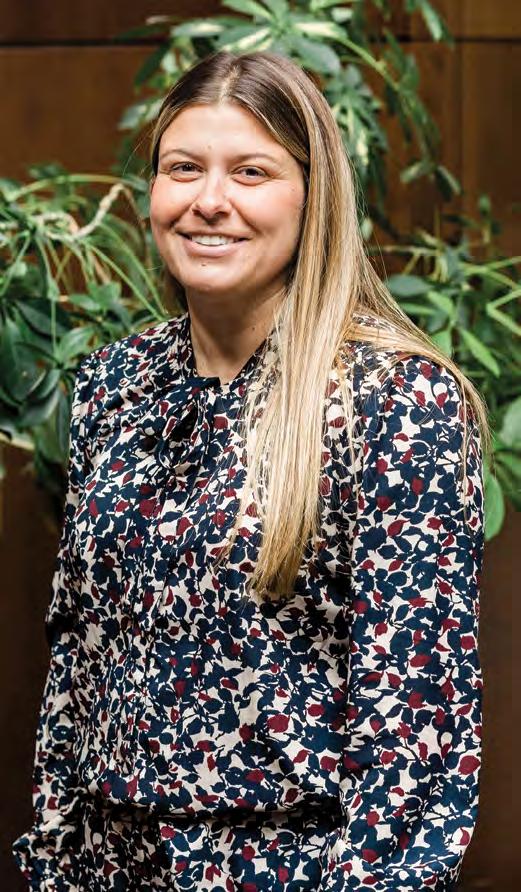

Dr.
2007 nysdental.org/renew 800.255.2100 Your Community for a Better Future Experience All Membership Has to Offer » 24/7 365 Support » Legal Resources » Up-to-the-Minute Industry Updates » Someone Always Advocating for You RENEW for 2023 Today 3 EASY WAYS TO PAY 1 ONLINE: nysdental.org/renew 2 MAIL: Return dues stub and payment 3 PHONE: 1-800-255-2100 PAYMENT PLAN 6-month installment payment plan that runs January through June. AUTO-RENEWAL Don’t ever forget to renew your membership again. Experience » Elevate » Engage
Kendra Zappia Member since
Students’ Perceptions of Teaching Methods for First-Year Dental Students during COVID-19
Ellen
D.D.S.;
ABSTRACT
The purpose of this study is to determine student perceptions of teaching methods for first-year dental students using Zoom to teach didactics and preclinical hand skills. Because of COVID-19, other teaching methods had to be implemented, and classes were held remotely. Our aim is to determine student perceptions of retention, understanding and learning of didactic and preclinical hands-on lectures. Students felt that didactic lectures through Zoom increased their retention and understanding in learning the material. They felt that preclinical hands-on lectures through Zoom were not as effective for their learning.
Major changes in all aspects of life occurred because of the COVID-19 pandemic. For those in education, the need for social distancing resulted in changing from in-person learning to online formats. Dental faculty needed to use virtual conferences, and students had to adjust their learning to this. Zoom was the main online platform used by faculty during this time.
At New York University College of Dentistry, there is a firstyear preclinical course to prepare students for clinical work. This course involves both didactic lectures and hands-on lab work.
Students learn about cavity preparations and fillings. Because of the restrictions of COVID-19, previous educational curriculum had to be modified, while still ensuring that students received all of the necessary learning to become competent dentists.
This study evaluates the students’ preferences among the virtual formats.

Methods
The study was approved by the Institutional Review Board of New York University College of Dentistry (IRB#FY2021-5303) with exempt status. An 11-question survey was sent through Qualtrics to the first-year dental students (D1) at New York University College of Dentistry. This voluntary, anonymous survey asked the students if Zoom increased, decreased or had no effect on their retention and understanding of didactic and preclinical hands-on lectures. It also asked if Zoom increased, decreased or had no effect on their learning, if a question-and-answer session should be at the end of the lecture, if students were able to visualize cavity preps taught virtually and their gender.
There were 76 D1 students who responded to the survey. The class has a total of over 300 students.
Results
Fifty-one percent of the students felt that their retention increased and 57% felt that their understanding increased on didactic lectures with Zoom (Figure 1). Fifty-seven percent of the
dental education
20 MARCH 2023 The New York State Dental Journal
Lee,
Jungwon Roh; Aspen Wang; Aaron Bai, D.D.S.; Huan-yu Chen, D.D.S.
students felt that their retention decreased and 51% felt that their understanding decreased on preclinical hands-on lectures; 66% felt that a question-and-answer session should be at the end of the lecture; 50% felt that they could visualize cavity preps through Zoom and 50% said they could not (Figure 2).

Discussion
Zoom is a software platform that allows for online video lectures to replace an in-person class. Learning through Zoom helped to increase retention and understanding of didactics. Both pre-pandemic in-person and online Zoom didactic courses are presented in a lecture format. Furthermore, in-person lectures and Zoom lectures are both recorded, which allows students to rewatch lectures. These similarities between in-person and Zoom lectures may account for a more seamless transition, as students indicated they were still able to increase their learning, retention and understanding of didactic material.
Prior to COVID-19, online learning programs were successfully implemented. The Vanderbilt University School of Nursing (VUSN) added a distanced learning option in 1996 and expanded the program over more than 20 years. Key factors for success included hiring additional staff for technology support, updating technological tool sets annually, implementing student and faculty technology orientations, and utilizing quality standards for course design. As a result, over 23 years, the VUSN Masters of Science in Nursing program rose to number eight in ranking for the year 2019, and the Doctor of Nursing Practice program rose to number five.[1]
A study of eLearning by Abassi et al. found that 40% of science students accepted eLearning as a good medium for acquiring theoretical knowledge and 47% preferred Zoom as an online platform.[2]
With Zoom, students can learn in a comfortable setting, as opposed to sitting in a lecture hall or classroom.[3] This is most helpful for commuting students. Many first-year dental students responded that they preferred Zoom lectures because they lived far from campus and did not have to commute to school. The time spent commuting was instead spent on reviewing or studying material. Armstrong-Mensah et al. found that more than a third of public health students surveyed at Georgia State School of Public Health reported that not having to commute to school was a positive outcome of distance learning.[4]
A recent survey conducted among first- to fourth-year dental students who had experienced both in-person and Zoom lectures found that students preferred podcast recordings over both Zoom and in-person lectures.[5] Likewise, Armstrong-Mensah et al.

The New York State Dental Journal ● MARCH 2023 21
found that most students also preferred this asynchronized style of online learning.[4] This preference may be because students have flexibility watching at faster speeds, pausing and replaying podcast recording.
Attendance rates and participation in lectures may be higher compared to when classes were in person.[6] Zoom involves multimedia learning, and students may be able to communicate with the lecturer and classmates more easily.[7]
One study of health science students found that nearly 75% of those surveyed considered clinics and laboratory environment more effective than eLearning for acquiring clinical and technical skills, and more than 75% of the students did not feel confident managing patients without practical and hands-on clinical sessions when returning to clinics after the pandemic.[2]
Another study of medical and dental faculty and students said they were unable to teach and learn practical and clinical work through online learning modalities.[8]
First-year dental students found that Zoom teaching was not as effective for retaining and understanding preclinical hands-on lectures. Comments from surveyed students suggest that courses with a hands-on focus do not translate well to online formats
without proper preparation. Key issues include a lack of adequate demonstrations and resources, inadequate feedback due to the lack of student access to quality equipment and not enough time for actual hands-on practice.
Surveyed students felt that preclinical courses, such as Head & Neck Anatomy and Dental Anatomy, did not add new technologies or resources for viewing, highlighted by comments such as: “Learning hands-on skills through Zoom is hard to visualize and provides no real practice”; “It was a huge challenge for me to really visualize the cavity preparations”; and “Another recommendation would be a better demonstration for some of the operative procedures over Zoom in regards to the cavity preparations.”
Other comments illustrate that not all students had proper technology: “Without the professional camera, I could not show the professor what I did; they often hardly give some structural suggestions.”




First-year dental students were scheduled to have an inperson lab session once a week for the Dental Anatomy course. However, students felt that this was not enough time to practice, illustrated by comments such as: “Having lab only 1 day a week unfortunately was not enough time for me to master the hands-
Dental Practice Financing for Members



For more information about this and other Endorsed Programs call: 800-255-2100
Bank of America practice specialists can help you achieve your goals with:
• Competitive terms on:

• Practice sales and purchases

• Office improvement and expansion
• Loans up to $5 million


• Flexible repayment options



• Business debt consolidation



• Reduced Fees for NYSDA Members
To learn more, call 800.428.2847 to talk to a practice specialist, or visit bankofamerica.com/practicesolutions to see all loan terms.
* When enlarging or reducing this logo, always make sure to select Scale Strokes & E ects to maintain the integrity of the gradients in the core graphic. Main Logo on White Background Vertical Logos on Reversed-out Main Logo on Charcoal Background (with drop shadow behind-right of core graphic) Main Logo on Carbon Fiber Background (with drop shadow behind-right of core graphic) Reversed-out Main Logo on Carbon Fiber Background
22 MARCH 2023 The New York State Dental Journal
on portion of the course”; and “It’s hard to translate that into hand/physical skills without putting the time in.” Furthermore, some students felt that not enough faculty members were available on lab days to answer questions.
Students also reported that they wished there were step-bystep instructions for how to prepare teeth for restoration. This may be because students prefer to hear instructions while simultaneously watching the steps on video.
It is important for educators and faculty to take steps to make these changes because students have various learning styles and needs. However, it was found that educators may be hesitant to make the changes because of how time-consuming it is to learn to use new technology, and some believe it is too difficult to do so.[9]
A study of dental residents rated the face-to-face format as significantly more conducive to student-instructor and studentstudent interaction.[10] In addition, dental clinical teaching and clinical student training directly on patients under close and remote supervision of senior clinical professionals and mentors are key to developing the essential clinical skills, competencies and clinical decision-making abilities mandatory for a dental graduate and general dental practitioner.[11,12]
Some students may be able to comprehend what cavity preps look like just by watching a short video or pictures of preps. However, most dental school students prefer a multimodal learning style within the VARK (visual, aural, read/write and kinesthetic) learning preferences. This means that dental students prefer to learn through a combination of sensory learning pathways instead of just one. Most dental students incorporate VARK in their learning styles.[13]
Outside materials, such as YouTube videos, may have helped first-year dental students better visualize cavity preps.
Our survey found that 66% of students felt that a questionand-answer session should be at the end of the lecture. This suggests that first-year students recognize that some degree of faculty-student interaction, a component of synchronous learning, is necessary despite the artificial distance of online learning.
Videotaped feedback may help novice learners in preclinical teaching.[14]
Conclusion
Based on our survey, first-year dental students feel that didactic lectures through Zoom increased their retention and understanding in learning the material. They felt that preclinical hands-on lectures through Zoom were not as effective in their learning. Initiating a question-and-answer session after the lecture may help to increase retention and understanding of the Zoom lectures. p
All authors have disclosed no relevant relationships. Queries about this article can be sent to Dr. Lee at el84@nyu.edu.
REFERENCES
1. Weiner E, McNew R, Gordon J, et al. Twenty plus years of distance learning: lessons learned. Student Health Technology Informatics 2019 Aug 21;264:1807-1808.
2. Abbasi MS, Ahmed N, Sajjad B, et al. E-Learning perception and satisfaction among health sciences students amid the COVID-19 pandemic.” Work 2020; 67(3):549-556.
3. Ruiz J, Mintzer M, Leipzig R. The impact of E-Learning in medical education. Academic Medicine 2006;81(31):207-212.
4. Armstrong-Mensah E, Ramsey-White K, Yankey B, Self-Brown S. COVID-19 and distance learning: effects on Georgia State University School of Public Health Students. Frontiers in Public Health. 8, 2020 Sep 25.
5. Impact of COVID-19 on different teaching methods. Chapter by: Lee E, Wang A, Roh J, Liang YS, Lee, TJ. In: Clinical & Educational Scholarship Showcase by New York NY: NYU College of Dentistry. NYU Academy of Distinguished Educators, 2021.
6. Schlenz MA, Schmidt A, Wöstmann B, et al. Students’ and lecturers’ perspective on the implementation of online learning in dental education due to SARS-CoV-2 (COVID-19): a cross-sectional study. BMC Medical Education 2020;20(1):354-361.
7. Nortvig AM., Petersen AK, Balle SH. A literature review of the factors influencing E-Learning and blended learning in relation to learning outcome, Student satisfaction and engagement. The Electronic Journal of E-Learning 2018;16(1):46-55.
8. Mukhtar K, Javed K, Arooj M, Sethi A. Advantages, limitations and recommendations for online learning during COVID-19 pandemic era. Pak J Med Sci 2020;36 (COVID19-S4): S27-S31.
9. Tricio JA, Montt JE, Ormeño AP, Del Real AJ, Naranjo CA. Impact of faculty development workshops in student-centered teaching methodologies on faculty members’ teaching and their students’ perceptions. J Dent Educ 2017;81(6):675-684.
10. Kunin M, Julliard KN, Rodriguez TE. Comparing face-to-face, synchronous, and asynchronous learning: postgraduate dental resident preferences. J Dent Educ 2014;78(6):856-866.
11. Elgezawi M, Hassan K, Alagl A, et al. Complexity of comprehensive care treatments in undergraduate dental programs: the benefits of observing and assisting experienced faculty members. Saudi Dent J 2017:29(4):161-166.
12. Taylor C, Grey N, Satterthwaite J. Assessing the clinical skills of dental students: a review of the literature. J Educ Learning 2013;2:20-31.
13. Aldosari MA, Aljabaa AH, Al-Sehaibany FS, Albarakati SF. Learning style preferences of dental students at a single institution in Riyadh, Saudi Arabia, evaluated using the VARK questionnaire. Advances in Medical Education and Practice 2018:9:179–186.
14. Shah DY, Dadpe, AM, Kalra DD, Garcha VP. Videotaped feedback method to enhance learning in preclinical operative dentistry: an experimental study. J Dent Educ 2015;79(12):14611466.
Ellen Lee, D.D.S., is clinical assistant professor, Department of Cariology and Comprehensive Care, New York University College of Dentistry, New York, NY.
Jungwon Roh and Aspen Wang are dental students at New York University College of Dentistry, New York, NY.
Aaron Bai, D.D.S., and Huan-yu Chen, D.D.S., are recent graduates of New York University College of Dentistry, New York, NY.
The New York State Dental Journal ● MARCH 2023 23
Platelet-derived Materials for the Treatment of Infrabony Periodontal Defects
A Systematic Review and Meta-analysis
Armando Uribe-Rivera, D.D.S, M.S.; Daniel Heffes, D.D.S.; Hans Malmström, D.D.S.;
Dongmei Li, Ph.D.; Yan-Fang Ren, D.D.S, Ph.D, M.P.H.
ABSTRACT
Aim: To compare the clinical outcomes of plateletderived biomaterials, including recombinant human platelet-derived growth factors receptor BB (rhPDGFBB), platelet-rich plasma (PRP) and platelet-rich fibrin (PRF), for treatment of periodontal infrabony defects.
Materials and Methods: A meta-analysis was conducted to compare pocket depth reduction (PRD) and clinical attachment gain (CAG) with and without rhPDGF-BB, PRP or PRF for surgical treatments of periodontal infrabony pockets. Eligible studies were randomized controlled clinical trials in adults with periodontal infrabony defects.
Results: Thirty-four randomized controlled trials involving 939 patients with a mean follow-up of 9.29(±2.49) months were included in this meta-analysis. All three platelet-derived materials achieved better outcomes in both PDR and CAG (p <0.00001) in comparison to controls. The effect size of the plateletderived biomaterials was on average 0.81(95%CI 0.62 to 0.99)mm [(0.96mm for PRF, 0.80mm for rhPDGFBB and 0.63mm for PRP)] for PDR, and 0.82 (95%CI
0.60 to 1.03)mm [( 0.92mm for PRF, 1.01mm for rhPDGF-BB and 0.60mm for PRP)] for CAG.
Conclusion: Periodontal therapies using plateletderived biomaterials improved PDR and CAG in the short term, compared to controls without these materials. However, there is not clinically significant PDR and CAG between the platelet materials.
Periodontitis is the most common inflammatory condition of bacterial origin. It causes destruction of the periodontal apparatus, including the alveolar bone, periodontal ligament and cementum, in addition to the gingival tissues.[1] Management of periodontal diseases is aimed at eliminating bacterial infections, reconstructing the periodontal apparatus, and restoring the masticatory function and general health of the individual.[2,3]
Fundamental periodontal treatments include two phases:
1. A disease-control phase that involves mechanical debridement and root scaling and planing to eliminate the bacterial pathogens, thus, modulating the host response to control or slow down periodontal disease progression.[4]
2. A reconstructive phase that aims at restoring periodontal anatomical structures destroyed by disease progression and involves periodontal therapies, including flap surgery, in addition to connective tissue and bone grafts (e.g., autografts, allografts, synthetic materials), for the purpose of tissue regeneration.
periodontology 24 MARCH 2023 The New York State Dental Journal
Based on evidence from histological studies,[5,6] these therapies resulted in tissue repair rather than tissue regeneration and, thus, failed to accomplish the goals of regenerative periodontal treatments.[7-9] Today, periodontal therapies for regeneration of periodontal tissues often incorporate molecular or cellular constructs, such as extracellular matrix proteins, growth factors, morphogens, biological mediators and/or precursor cells onto the surgical sites.[10] However, clinical outcomes of these novel therapeutic modalities remain to be thoroughly investigated.
It has been shown that an array of products containing platelet-derived growth factors led to regeneration of alveolar bone, vascular structures and soft tissues of the periodontium.[11,12] These include PRP, PRF and rhPDGF-BB. [13,14] PRP is a concentrate that contains from 2- to 8.5-fold increase of platelets obtained from autologous blood. When delivered locally, PRP has the capability of increasing the proliferation of fibroblasts, osteoblasts and angiogenesis, aiding the formation of new periodontal tissues.[15]
PRF is considered a second-generation platelet concentrate that enables the operator to obtain fibrin membranes enriched with platelets, growth factors, leucocytes, cytokines and circulating stem cells from autologous blood. This natural scaffold was found to play a key role in hard- and soft-tissue repair processes.[16]
On the other hand, rhPDGF-BB is often used with various scaffolds as carriers to enhance the molecular and cellular functions involved in regeneration of the target periodontal structures. [17-20] Application of rhPDGF-BB may enhance mitogenic and chemotactic activities that facilitate tissue regeneration in the targeted areas.[10,21] Carrier scaffolds that emulate the characteristics of native jaw bone have shown to increase the inductive capacity of cells and facilitate blood vessel distributions, which are conducive to new tissue formation and vascular regeneration in the affected site.[22] For instance, Beta-tricalcium phosphate (β-TCP), a synthetic material commonly used in conventional periodontal therapies, led to the improvement of clinical outcomes due to its biocompatibility with human tissues in the periodontium.
[10] Combination of rhPDGF-BB with such carrier scaffolds may further enhance the clinical outcomes.
Though these platelet-derived biomaterials are purported to act through a similar mechanism to enhance tissue regeneration, they vary in preparation, application and cost. Numerous studies involving these products have claimed varying degrees of success in clinical applications for periodontal tissue regeneration. But, it is not known if one product is superior to another in terms of clinical outcomes. The objectives of this study were, therefore, to perform a systematic review and meta-analysis using infrabony periodontal defects to estimate clinical outcomes measured (by pocket depth reduction [PDR] and clinical attachment gain [CAG]), following applications of PRP, PRF or rhPDGF-BB in comparison to conventional periodontal techniques. We aim to answer the following two questions: 1. Is PRP, PRF or rhPDGF-BB more effective than controls in achieving PDR and CAG in patients with periodontal intrabony pockets? 2. Is one of these products superior to another in improving treatment outcomes measured in PDR and CAG?
Materials and Methods
This systematic review and meta-analysis were designed and conducted in accord with the Preferred Reporting Items for Systematic Reviews and Meta-Analysis (PRISMA) statement.

The New York State Dental Journal ● MARCH 2023 25
Figure 1. Flowchart of Inclusion Criteria or Articles in this Study.
A. Focused PICO Question
The following statements were used to conduct the systematic search:
• Population (P) = systemically healthy humans with periodontal intrabony defects.
• Inter vention (I) = use of a platelet-derived material, either rhPDGF-BB or PRF or PRP, in periodontal surgery for treatments of infrabony pockets.
• Comparison (C) = periodontal surgery without the use of the platelet-derived materials for treatments of infrabony pockets. The protocols for periodontal surgery are the same in the comparison group as in the intervention group, with the sole difference being with or without the platelet-derived materials.
• Outcome (O) = PDR and CAG at a minimum of 6 months and maximum of 12 months.
A PICO question was created to carry out the literature search: “Among clinical trials that combine either rhPDGF-BB, PRF or PRP with periodontal surgery for the management of periodontal intrabony defects, do adults with periodontal diseases exhibit improved PDR and CAG compared to periodontal surgeries without these materials?”
B. Literature Search
We searched the literature from January 1997 through January 2021 utilizing four electronic databases (PubMed [http://www.ncbi.nlm. nih.gov/oubmed]; Cochrane [http://www.cochrane.org]; CINAHL [https://www.ebscohost.com/nursing/products/cinahl-databases]; and Web of Science [htpp://apps.webofknowledge.com]).
We used specific headings and keywords as follows:
For PubMed—(Platelet Derived Growth Factor or PGDF) (Platelet-Rich Fibrin or PRF) and (Platelet-Rich Plasma or PRP or Platelet Concentrate) and (Bone Regeneration or Bone Regenerat* or Osteoconduction) and (Adult or Adult* or Elder or Elder* or Middle Aged or Middle Age or Young Adult or Young Adult*) and (Randomized Controlled Trial[ptyp])[(Platelet Derived Growth Factor or PDGF) and (Bone Regeneration or Bone Regenerat* or Osteoconduction) and (Adult or Adult* or Elder or Elder* or Middle Aged or Middle Age or Young Adult or Young Adult*) and (Randomized Controlled Trial[ptyp]).
For Cochrane—(Platelet Derived Growth Factor or PGDF) and (Bone Regeneration or Bone Regenerat* or Osteoconduction) and (Adult or Adult* or Elder or Elder* or Middle Aged or Middle Age or Young Adult or Young Adult*).
For Web of Science—(Platelet Derived Growth Factor or PGDF) (Platelet-Rich Fibrin or PRF) and (Platelet-Rich Plasma or PRP or Platelet Concentrate) and ((Bone Regeneration or Bone Regenerat*) or Osteoconduction) and (Adult or Adult* or Elder or Elder* or Middle Aged or Middle Age or Young Adult or Young Adult*) and (clinical trial* or research design or comparative stud* or evaluation stud* or controlled trial* or follow-up stud* or prospective stud* or random* or placebo* or single blind* or double blind*)).
For CINHAL—(MH “Platelet-Derived Growth Factor”) or “Platelet Derived Growth Factor” or PGDF) and ((MH “Platelet-Rich Fibrin”) or “Platelet Rich Fibrin” or “PRF”) and (MH “PlateletRich Plasma”) or “Platelet Rich Plasma” or “PRP” or “Platelet Concentrate”)(MH “Bone Regeneration+”) or “Bone Regeneration” or Osteoconduction) - Narrow by Subject Age: - all adult.
C. Screening and Eligibility
Studies were included only if all of the following eligibility criteria were met: 1) published in English; 2) reported the use of rhPDGFBB, PRF or PRP; 3) randomized controlled clinical trials; 4) reported descriptive statistics on clinical periodontal outcomes, including PDR and CAG (sample size, mean, standard deviation for two experimental arms, including both baseline and postoperative assessments). Studies were excluded if they showed: 1) different modalities other than the use of rhPDGF-BB, PRF and PRP; 2) case reports or 3) case series; and 4) animal studies. Of note, the titles and abstracts obtained from the first search were screened independently by two reviewers (M.L., F.A.M.). When publications did not meet the inclusion criteria, they were excluded upon reviewers’ agreement.
A second screening of articles was performed by Drs. H.D. and U.R.A., which included more recent publications to be included in the study. Any disagreement between the reviewers was resolved by reaching consensus through discussion. All full texts of the potential articles were obtained and examined by two reviewers (U.R.A. and Y.F.R). Data from the articles were reviewed twice and agreement between the two reviewers was accomplished, so that final eligibility of the articles was assured. All studies that fulfilled all selection criteria were processed for data extraction.
D. Quality Assessment of Clinical Trials
The Oxford quality scoring system (JADAD scoring) was utilized to appraise the quality of the clinical trial. [23] For purposes of this meta-analysis, those studies that received a JADAD score between four and five points were considered for analysis (Table 1).
E. Data Management and Statistical Analysis [23]
The outcome variables were PDR and CAG in millimeters measured at a minimum of six months of follow-up after the periodontal surgery. Mean values and standard deviations (SD) were extracted for each group (Figures 2,3). All data were arranged in groups for the inter-group comparison (experimental versus control groups between rhPDGF-BB, PRF and PRP therapies). A meta-analysis was performed using the random model for all three platelet biomaterials, when heterogeneity (I2 proportion) was high and the fixed model when heterogeneity was low. The mean difference was calculated and a 95% confidence interval was computed. Forest plots were created to display the analysis using Review Manager (RevMan Version 5.3. Copenhagen: The Nordic Cochrane Centre, The Cochrane Collaboration, 2014). All statistical tests were two-sided, with alpha <0.05 being considered significant.
26 MARCH 2023 The New York State Dental Journal

F. Clinical Significant PDR and CAG
For purposes of this meta-analytic study, the mean difference of >0.7mm for both PDR and CAG was considered clinically significant based on the study by Zamet JS, et al. with similar outcomes, which most of the studies included in this study used for power analysis.[24]
Results
A. Literature Search and Study Selection
The database-search identified 311 studies, of which 21 were duplicates (Figure 1). A total of 290 articles were included for title and abstract screening. From those, 80 articles were included for full-text review. Forty-nine articles were excluded after full-text review, which was conducted independently by two reviewers (A.U.R., D.H.). After reviewing the included articles, there was a consensus of these studies between Y.F.R. and A.U.R. for verifying values, clinical outcomes and quality of studies. Thirty-one randomized control trials fulfilled the inclusion criteria and were included for analysis (Table 1). Of note, JADAD scores of all the included studies reached a score of four out of five points due to lack of placebo treatments in their designs.
B. Description of the Studies
In the 31 studies that underwent data extraction, 939 individuals underwent periodontal open-flap surgeries combined with either tissue debridement or guided-tissue regeneration that included the use of bone grafting materials or a combination of both techniques and were followed up at 9.29+2.49 (range of 6 to 12 months). For the only study that had a length of follow-up greater than 12 months,[25] only the measurements at 12 months were included for the purpose of this meta-analysis.
Articles included for this study (n=31) were grouped into traditional periodontal surgery in combination with platelet-derived materials (experimental group) and traditional periodontal methods without platelet-derived materials (control group). The platelet-derived materials were broken down into three subgroups: rhPDGF-BB, PRP and PRF (Table 1).
B.1. rhPDGF-BB group
Seven studies used rhPDGF-BB (n=331 subjects) in combination with periodontal surgery. Of the seven articles, five studies reported the use of β-TCP as grafting material.[6,22,25-27] One study used 1% sodium hyaluronate gel,[28] and one study used stem cells cultured in β-TCP in the experimental group.[29] The same grafting materials were used in the control group, without the incorporation of rhPDGF-BB in them for all the seven studies.
B.2. PRP group
Fourteen studies used PRP (n=374 subjects) in combination with periodontal surgery.[9,13, 29-42] Of the 15 articles, 5 used a com-
bination of bovine porous bone mineral;[13,30-33] three studies used a combination of PRP and β-TCP.[34-36] Two studies used a combination of PRP with enamel matrix derivatives and natural bone mineral.[37,38] Two studies used a combination of PRP with alloplastic grafts, including either bioactive glass[39] or hydroxyapatite.[40] One study utilized a combination of PRP with demineralized freeze-dried bone allograft.[41] Two studies used PRP alone in the experimental group.[9,42]
B.3. PRF group
Ten studies were analyzed for PRF (n=234 subjects) in combination with periodontal surgery.[9,43-52] Of the nine studies, one used a combination of PRF with enamel matrix derivatives,[50] and one used a combination of PRF with anorganic bovine bone mineral.[52] One study used a combination of PRF with alloplastic (bioactive glass) graft,[53,54] and one used the combination of PRF and hydroxyapatite graft in the experimental groups.[46] Six studies used PRF alone as membrane for periodontal regeneration. [9,45-47,49,51] It is important to highlight that one study included two combinations of PRF (PRF alone and PRF + hydroxyapatite). [46] The same products, but without the PRF, were used in the control groups.
C. Assessment of heterogeneity
Heterogeneity was evaluated among the studies for the meta-analysis comparison of PDR and CAG. In the present study, a high heterogeneity was found among studies for both PDR (I2 = 82%) and CAG (I2 = 85%). However, a low heterogeneity was found between studies which evaluated the use of rhPDGF-BB (I2 = 16%) and PRF (I2 = 38%) for PDR. The other subgroups and clinical outcomes showed high heterogeneity, including; rhPDGF-BB (I2 = 84%) and PRF (I2 = 55%) for CAG and PRP for both the PDR and the CAG (I2 = 90%).
C.1. Study design
All studies were randomized clinical trials and frequently presented a split-mouth design. The articles and study characteristics are presented in Table 1.
C.2. Surgical protocol
Surgical protocols used in the included studies involved traditional periodontal flaps and open-flap debridement as presented in Table 1.
C.3. Clinical periodontal measurements
A standardized assessment was used for pocket-depth defect and clinical attachment level. Anatomical landmarks for both baseline and postoperative periodontal tissues assessment included cemento-enamel junction, alveolar crest and base of the defect. The clinical parameters were recorded to the nearest millimeter with the help of a periodontal probe. This assessment method was
28 MARCH 2023 The New York State Dental Journal
described in 30 studies. Therefore, only one study did not describe the technique used for periodontal tissues assessment.[25]
D. Meta-analyses
Overall, the results of the random effect meta-analysis favored the use of platelet-derived materials over controls. Experimental groups achieved greater PDR (P = <0.00001) and CAG (P = <0.00001) than the control groups. The random-effect mean difference between control and experimental therapies was 0.81mm (95%CI 0.62 to 0.99mm) in PDR (Figure 2A) and 0.82mm (95%CI 0.60 to 1.03mm) in CAG (Figure 2B).
D.1: PRF vs. controls
In this subgroup, PRF in combination with periodontal surgery achieved a mean difference of 0.96mm (95% CI 0.71 to 1.21mm) higher in PDR (P = < 0.00001) and a mean difference of 0.92mm (95% CI 0.62 to 1.22mm) larger in CAG (P = < 0.00001), when compared to controls. (Figures 3A, 4A).
TABLE 1
Characteristics of Included Studies for Meta-analysis

D.2: rhPDGF-BB vs. controls
In this subgroup, rhPDGF-BB in combination with traditional periodontal surgery achieved a mean difference of 0.80mm (95% CI 0.61 to 0.99mm) higher in PDR (P = <0.00001) and 1.01mm (95%CI 0.55 to 1.48mm) larger in CAG (P = <0.0001) than controls (Figures 3B, 4B).
D.3: PRP vs. controls
In this subgroup, PRP in combination with periodontal surgery achieved a mean difference of 0.63mm (95% CI 0.26 to 1.01mm) higher in PDR (P = 0.0009) and 0.60mm (95%CI 0.17 to 1.03mm) larger in CAG (P = 0.006) than controls (Figures 3C, 4C).
Discussion
The purpose of this study was to evaluate the effects of plateletderived biomaterials on PDR and CAG when used for treating infrabony defects in periodontal patients. We found that the use of
The New York State Dental Journal ● MARCH 2023 29
rhPDGF-BB, PRP and PRF with periodontal surgery improved the clinical outcomes when compared to the controls without these biological materials. Additionally, compared to rhPDGF-BB and PRP, PRF moderately enhanced both PDR and CAG.
In the field of dentistry, in the last decade, platelet biomaterials have been used extensively in periodontal tissues.[55,56]
The meta-analysis results of our study showed that incorporating platelet-derived biomaterials in traditional periodontal methods, displayed an improvement in both the PDR and the CAG when compared with controls. Other reports showed similar clinical outcomes and suggested that the advantage of using platelet biomaterials with other tissue-regenerative methods in the peri-

odontum is linked with the continuing release of the autologous growth factors from platelets onto periodontal tissues.[57-59] Furthermore, it has been shown that these autologous growth factors stimulate biologic processes, including chemotaxis, angiogenesis, cell proliferation and differentiation for enhancing tissue regeneration.[60-62] Hence, the application of the platelet biomaterials
in periodontal surgery is gaining momentum with promising clinical outcomes.
A major periodontal surgery goal is to improve the formation of tooth-supporting structures affected by periodontal disease.[63] Platelet biomaterials are assumed to increase the effectiveness of periodontal techniques.[64] However, little is known about the

comparison of the effectiveness of each of the platelet biomaterials, including rhPDGF, PRP and PRF, on infrabony periodontal defects. This study demonstrated that PRF was superior to rhPDGF and PRP for enhancing PDR and CAG.
Other studies reported similar outcomes using PRF. They suggested that PRF is a more standardized, slow-type polymerization technique which may enhance platelet capability for releasing growth factors for longer periods.[16,25,62,65-67] In addition, the findings in our study are also similar, when compared to other systematic reviews on PRF and periodontal outcomes.[55,68] For instance, Verma et al. showed that PRF combined with other biomaterials for grafting methods displayed superior periodontal outcomes to those demonstrated when the same grafting materials were used alone.[55] It is noteworthy that other reports suggested that PRF effectiveness is questionable when it is the only material used in periodontal methods.[68]
In contrast with the study by Najeeb et al. the PDR and CAG of >1.00mm in our meta-analysis included those studies which utilized PRF alone as a membrane. Hence, we suggest that the systematic review by Najeeb et al. combined studies that included both case reports and randomized clinical trials with low methodological quality. This factor is important for proper analysis and interpretation of the data and for minimizing publication bias.[23] Another important factor in our study, different from Najeeb’s report, is that all of the included papers in our study were considered of high methodological quality.
Limitations for this study included the high heterogeneity between some of the comparisons in this meta-analysis. This potentially biased some of the assumptions taken into account in the meta-analysis results of this study and the findings should be viewed with caution. A second limitation in this study is found on the follow-up period among studies, which ranges from 6 to 12 months. It is paramount that more studies with longer followup evaluations, using platelet-derived biomaterials, be designed to determine the platelet biomaterial’s efficacy in the long term.
The strengths of this study are found in the appraisal and thorough search and analysis of the randomized clinical trials using the three different platelet biomaterials in a specific periodontal condition. In our opinion, there was a dearth of information in the dental literature when comparing the three platelet-derived therapies and their efficacy in periodontal outcomes. This question is properly addressed in this meta-analysis.
It is important to mention that the findings in this study showed not only a high degree of statistical significance in the comparison of clinical outcomes between the experimental and control groups, it also demonstrated that these findings were clinically significant to enhance periodontal tissues affected in periodontal disease.
This study opened other questions for future studies, including: 1) what is the cost-effectiveness of each platelet biomaterial, when compared to another; and 2) what is the long-term effect of
platelet biomaterials in the periodontum and what is their benefit in incorporating them in periodontal surgery methods?
In conclusion, our results provide dental professionals with a scientific foundation for making appropriate decisions in the short-term with respect to the use of platelet-derived biomaterials in conjunction with periodontal surgery for the management of infrabony periodontal defects. Based on our meta-analysis and literature search, we determined that there is clinically significant PDR and CAG, when incorporating platelet biomaterials in surgical periodontal therapies. However, there is not clinically significant PDR and CAG between the platelet materials.p
The authors thank the Clinical and Translational Institute at the University of Rochester for services on statistical methods, as well as the following: Librarian Lorraine Porcello, Eastman Institute for Oral Health, and Librarian Daniel Castillo, School of Medicine and Dentistry, University of Rochester, for collaboration and literature search; Drs. Edith Gonzalez-James, D.D.S.., Lakshmidevi Ranjan Mandava R.L, B.D.S., and Marcela Flores-Amador, D.D.S., former residents at EIOH, for assistance with initial literature search; and Dr. John H. Campbell, D.D.S., M.S., FACS, Department of Oral and Maxillofacial Surgery, University at Buffalo, and OMS Dr. Gilbert H. Schulenberg, D.D.S., of Buffalo, for assistance in editing of this manuscript. Queries about this article can be sent to Dr. Uribe-Rivera at aur@bu.edu.
REFERENCES
1. Williams RC. Periodontal disease. N Engl J Med 1990;322(6):373-82.
2. Costa FO, et al. Surgical and nonsurgical procedures associated with recurrence of periodontitis in periodontal maintenance therapy: 5-year prospective study. PLoS One 2015;10(10):e0140847.
3. Pajnigara N, et al. Diagnostic accuracy of cone beam computed tomography in identification and postoperative evaluation of furcation defects. J Indian Soc Periodontol 2016;20(4):386-390.
4. Howell TH, et al. A phase I/II clinical trial to evaluate a combination of recombinant human platelet-derived growth factor-BB and recombinant human insulin-like growth factorI in patients with periodontal disease. J Periodontol 1997;68(12):1186-93.
5. Caton J, Nyman S. Histometric evaluation of periodontal surgery. I. The modified Widman flap procedure. J Clin Periodontol 1980;7(3):212-23.
6. Maroo S, Murthy KR. Clinical and radiographic evaluation of recombinant human platelet derived growth factor with beta tricalcium phosphate in the treatment of a periodontal intrabony defect. J Indian Soc Periodontol 2014;18(6): 789-93.
7. Wang HL,Greenwell H. Surgical periodontal therapy. Periodontol 2000 2001;25:89-99.
8. Polimeni G, Xiropaidis AV, Wikesjo UM. Biology and principles of periodontal wound healing/regeneration. Periodontol 2000 2006;41:30-47.
9. Pradeep AR, et al. Comparative evaluation of autologous platelet-rich fibrin and plateletrich plasma in the treatment of 3-wall intrabony defects in chronic periodontitis: a randomized controlled clinical trial. J Periodontol 2012;83(12):1499-507.
10. Nevins M, et al. Platelet-derived growth factor stimulates bone fill and rate of attachment level gain: results of a large multicenter randomized controlled trial. J Periodontol 2005;76(12):2205-15.
11. Dereka XE, Markopoulou CE, Vrotsos LA. Role of growth factors on periodontal repair. Growth Factors 2006;24(4):260-7.
12. Babo PSR, RL, Gomes ME. Periodontal tissue engineering: current strategies and the role of platelet rich hemoderivatives. Journal of Materials Chemistry B 2017;5:3617-3628.
13. Ouyang XY, Qiao J. Effect of platelet-rich plasma in the treatment of periodontal intrabony defects in humans. Chin Med J (Engl) 2006;119(18):1511-21.
14. Chang YCZ, JH. Effects of platelet-rich fibrin on human periodontal ligament fibroblasts and application for periodontal infrabony defects. Australian Dental Journal 2011;56(4):365-71.
15. Marx RE, et al. Platelet-rich plasma: Growth factor enhancement for bone grafts. Oral Surg Oral Med Oral Pathol Oral Radiol Endod 1998;85(6): 638-46.
16. Kumar YR, et al. Platelet-rich fibrin: the benefits. Br J Oral Maxillofac Surg 2016;54(1):57-61.
17. Andrew JG, et al. Platelet-derived growth factor expression in normally healing human fractures. Bone 1995;16(4):455-60.
18. Heldin CH, Ostman A, Ronnstrand L. Signal transduction via platelet-derived growth factor receptors. Biochem Biophys Acta 1998;1378(1):F79-113.
19. Rosenkranz S, Kazlauskas A. Evidence for distinct signaling properties and biological responses induced by the PDGF receptor alpha and beta subtypes. Growth Factors 1999;16(3):201-16.
32 MARCH 2023 The New York State Dental Journal
20. Furuhashi M, et al., Platelet-derived growth factor production by B16 melanoma cells leads to increased pericyte abundance in tumors and an associated increase in tumor growth rate. Cancer Res 2004;64(8):2725-33.
21. Lynch SE, et al., The effects of short-term application of a combination of platelet-derived and insulin-like growth factors on periodontal wound healing. J Periodontol 1991;62(7): 458-67.
22. Thakare K, Deo V. Randomized controlled clinical study of rhPDGF-BB + beta-TCP versus HA + beta-TCP for the treatment of infrabony periodontal defects: clinical and radiographic results. Int J Periodontics Restorative Dent 2012; 32(6):689-96.
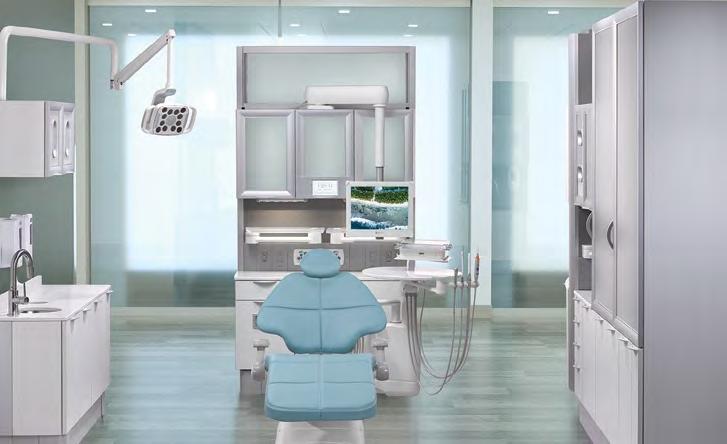
23. Berger VW, Alperson SY. A general framework for the evaluation of clinical trial quality. Rev Recent Clin Trials 2009;4(2):79-88.
24. Zamet JS, et al. Particulate bioglass as a grafting material in the treatment of periodontal intrabony defects. J Clin Periodontol 1997;24(6):410-8.
25. Nevins M, et al. Platelet-derived growth factor promotes periodontal regeneration in localized osseous defects: 36-month extension results from a randomized, controlled, doublemasked clinical trial. J Periodontol 2013;84(4):456-64.
26. Jayakumar A, et al. Multi-centre, randomized clinical trial on the efficacy and safety of recombinant human platelet-derived growth factor with beta-tricalcium phosphate in human intra-osseous periodontal defects. J Clin Periodontol 2011;38(2):163-72.
27. Kavyamala D, et al. Evaluation of the efficacy of a 1:1 mixture of beta-TCP and rhPDGF-BB in the surgical management of two- and three-wall intraosseous defects: a prospective clinical trial. Int J Periodontics Restorative Dent 2019; 39(1):107-113.
28. Mishra AA, H, Pathakota KR, Avula J. Efficacy of modified minimally invasive surgical technique in the treatment of human intrabony defects with or without use of rhPDGF-BB gel – a randomized controlled trial. Journal of Clinical Periodontology 2013;40:172–179.
29. Dhote R, et al. Stem cells cultured on Beta Tricalcium Phosphate (beta-TCP) in combination with recombinant human platelet-derived growth factor - BB (rh-PDGF-BB) for the treatment of human infrabony defects. J Stem Cells 2015; 10(4):243-54.
30. Lekovic V, et al. Effectiveness of a combination of platelet-rich plasma, bovine porous bone mineral and guided tissue regeneration in the treatment of mandibular grade II molar furcations in humans. J Clin Periodontol 2003;30(8): 746-51.
31. Camargo PM, et al. A surgical reentry study on the influence of platelet-rich plasma in enhancing the regenerative effects of bovine porous bone mineral and guided tissue regeneration in the treatment of intrabony defects in humans. J Periodontol 2009;80(6): 915-23.
32. Hanna R, Trejo PM, Weltman RL. Treatment of intrabony defects with bovine-derived xenograft alone and in combination with platelet-rich plasma: a randomized clinical trial. J Periodontol 2004;75(12):1668-77.
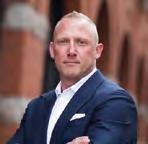
33. Dori F, et al. Effect of platelet-rich plasma on the healing of intrabony defects treated with an anorganic bovine bone mineral: a pilot study. J Periodontol 2009;80(10):1599-605.
34. Christgau M, et al., Influence of autologous platelet concentrate on healing in intrabony defects following guided tissue regeneration therapy: a randomized prospective clinical splitmouth study. J Clin Periodontol 2006;33(12):908-21.
35. Moder D, et al. Influence of autogenous platelet concentrate on combined GTR/graft therapy in intrabony defects: a 7-year follow-up of a randomized prospective clinical split-mouth study. J Clin Periodontol 2012;39(5):457-65.
36. Yassibag-Berkman ZT, Subasioglu O, Kantarci A. Combined use of platelet-rich plasma and bone grafting with or without guided tissue regeneration in the treatment of anterior interproximal defects. Journal of Periodontology 2007;78: 801-809.
37. Dori F, et al. Effect of platelet-rich plasma on the healing of intrabony defects treated with Beta tricalcium phosphate and expanded polytetrafluoroethylene membranes. J Periodontol 2008;79(4):660-9.
38. Dori F, et al. Five-year results evaluating the effects of platelet-rich plasma on the healing of intrabony defects treated with enamel matrix derivative and natural bone mineral. J Periodontol 2013;84(11):1546-55.
39. Demir B, Sengun D, Berberoglu A. Clinical evaluation of platelet-rich plasma and bioactive glass in the treatment of intrabony defects. J Clin Periodontol 2007;34(8):709-15.
40. Okuda K, et al. Platelet-rich plasma combined with a porous hydroxyapatite graft for the treatment of intrabony periodontal defects in humans: a comparative controlled clinical study. J Periodontol 2005;76(6):890-8.
41. Piemontese M, et al. Treatment of periodontal intrabony defects with demineralized freezedried bone allograft in combination with platelet-rich plasma: a comparative clinical trial. J Periodontol 2008;79(5):802-10.
Services We Offer: ✔ PRACTICE SALES & MERGERS ✔ TRANSITION PLANNING ✔ ASSOCIATE PLACEMENTS ✔ PARTNERSHIP AGREEMENTS ✔ PRACTICE VALUATIONS Professional Guidance & Proven Processes for every step of your dental transition Justin R. Baumann DDSmatch NY & Western PA Phone: 855.546.0044 Direct: 716.266.9707 jbaumann@ddsmatch.com Transition on your Terms with DDSmatch Are you Ready? It's not too early to start a conversation. Call today to schedule your complimentary, confidential call. The New York State Dental Journal ● MARCH 2023 33
42. Pradeep AR, et al. Clinical effectiveness of autologous platelet-rich plasma and Peptide-enhanced bone graft in the treatment of intrabony defects. J Periodontol 2009;80(1): 62-71.
43. Sharma A, Pradeep AR. Autologous platelet-rich fibrin in the treatment of mandibular degree II furcation defects: a randomized clinical trial. J Periodontol 2011;82(10):1396-403.
44. Sharma A, Pradeep AR. Treatment of 3-wall intrabony defects in patients with chronic periodontitis with autologous platelet-rich fibrin: a randomized controlled clinical trial. J Periodontol 2011;82(12):1705-12.
45. Pradeep AR, et al. Platelet-rich fibrin with 1% metformin for the treatment of intrabony defects in chronic periodontitis: a randomized controlled clinical trial. J Periodontol 2015;86(6):729-37.
46. Pradeep AR, et al. Platelet-rich fibrin combined with a porous hydroxyapatite graft for the treatment of 3-wall intrabony defects in chronic periodontitis: a randomized controlled clinical trial. J Periodonto 2017;88(12): 1288-1296.
47. Thorat M, Pradeep AR, Pallavi B. Clinical effect of autologous platelet-rich fibrin in the treatment of intrabony defects: a controlled clinical trial. J Clin Periodontol 2011;38(10): 925-32.
48. Bajaj P, et al. Comparative evaluation of autologous platelet-rich fibrin and platelet-rich plasma in the treatment of mandibular degree II furcation defects: a randomized controlled clinical trial. J Periodontal Res 2013;48(5):573-81.
49. Bajaj P, et al. Autologous platelet-rich fibrin in the treatment of 3-wall intrabony defects in aggressive periodontitis: a randomized controlled clinical trial. J Periodontol 2017;88(11):1186-1191.
50. Aydemir Turkal H, et al. Evaluation of the adjunctive effect of platelet-rich fibrin to enamel matrix derivative in the treatment of intrabony defects. Six-month results of a randomized, split-mouth, controlled clinical study. J Clin Periodontol 2016;43(11):955-964.
51. Patel GK, et al. Platelet-rich fibrin in regeneration of intrabony defects: a randomized controlled trial. J Periodontol 2017;88(11):1192-1199.
52. Sezgin Y, et al. Effects of platelet-rich fibrin on healing of intrabony defects treated with anorganic bovine bone mineral. Braz Oral Res 2017;31:e15.
53. Naqvi A, et al. Comparative evaluation of bioactive glass putty and platelet rich fibrin in the treatment of human periodontal intrabony defects: a randomized control trial. J Clin Diagn Res 2017;11(7): ZC09-ZC13.
54. Bodhare GH, et al. Clinical and radiographic evaluation and comparison of bioactive bone alloplast morsels when used alone and in combination with platelet-rich fibrin in the treatment of periodontal intrabony defects-a randomized controlled trial. J Periodontol 2019;90(6):584-594.
55. Verma UP, et al. Platelet-rich fibrin: a paradigm in periodontal therapy -a systematic review. J Int Soc Prev Community Dent 2017;7(5):227-233.
56. Mihaylova Z, et al. Use of platelet concentrates in oral and maxillofacial surgery: an overview. Acta Odontol Scand 2017;75(1):1-11.
57. Ridgway HK, MellonigJT, Cochran DL. Human histologic and clinical evaluation of recombinant human platelet-derived growth factor and beta-tricalcium phosphate for the treatment of periodontal intraosseous defects. Int J Periodontics Restorative Dent 2008;28(2):171-9.
58. Singh P, Suresh DK. Clinical evaluation of GEM 21S(R) and a collagen membrane with a coronally advanced flap as a root coverage procedure in the treatment of gingival recession defects: a comparative study. J Indian Soc Periodontol 2012;16(4):577-83.
59. Rosen PS, et al. A retrospective consecutive case series using mineralized allograft combined with recombinant human platelet-derived growth factor BB to treat moderate to severe osseous lesions. Int J Periodontics Restorative Dent 2011; 31(4):335-42.
60. Okuda K, et al. Platelet-rich plasma contains high levels of platelet-derived growth factor and transforming growth factor-beta and modulates the proliferation of periodontally related cells in vitro. J Periodontol 2003;74(6):849-57.
61. Zhang S, et al. Effects of platelet-rich plasma on the activity of human menstrual bloodderived stromal cells in vitro. Stem Cell Res Ther 2018;9(1):48.
62. Weibrich G, Kleis WG, Hafner G. Growth factor levels in the platelet-rich plasma produced by 2 different methods: curasan-type PRP kit versus PCCS PRP system. Int J Oral Maxillofac Implants 2002;17(2):184-90.
63. Tozum TF, Demiralp B. Platelet-rich plasma: a promising innovation in dentistry. J Can Dent Assoc 2003;69(10): 664.
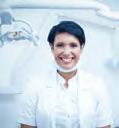
64. Forni F, et al. Platelet gel: applications in dental regenerative surgery. Blood Transfus 2013;11(1):102-7.
65. Dohan Ehrenfest DMB, T, Jimbo R, Barbé G,Del Corso M, Inchingolo F, Sammartino G. Do the fibrin architecture and leukocyte content influence the growth factor release of platelet concentrates? An evidence-based answer comparing a pure platelet-rich plasma (P-PRP) gel and a leukocyte- and platelet-rich fibrin (L-PRF). Current Pharmaceutical Biotechnology 2012;13:1145-1152.
66. Marenzi G, et al. Influence of leukocyte- and platelet-rich fibrin (L-PRF) in the healing of simple postextraction sockets: a split-mouth study. Biomed Res Int 2015 2015:369273.
67. Dohan Ehrenfest DM, et al. The impact of the centrifuge characteristics and centrifugation protocols on the cells, growth factors, and fibrin architecture of a leukocyte- and plateletrich fibrin (L-PRF) clot and membrane. Platelets 2018; 29(2):171-184.
68. Najeeb S, et al. Regenerative potential of platelet rich fibrin (PRF) for curing intrabony periodontal defects: a systematic review of clinical studies. Tissue Eng Regen Med 2017;14(6):735-742.
Armando Uribe-Rivera, D.D.S, M.S., is clinical assistant professor, Boston University Department Oral and Maxillofacial Surgery. He was previously employed in the Urgent Care Department at Eastman Institute for Oral Health of the University of Rochester, Rochester, NY.
Daniel Heffes, D.D.S., is a private practitioner and former resident, General Dentistry Department, Eastman Institute for Oral Health of the University of Rochester, Rochester, NY.
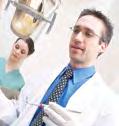
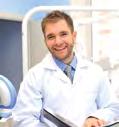
Hans Malmström, D.D.S., is the chairman of the General Dentistry Department, Eastman Institute for Oral Health, University of Rochester, Rochester, NY.
Dongmei Li, Ph.D., is a member of the Clinical and Translational Research Institute, Department of Biostatistics, University of Rochester, Rochester, NY.
Yan-Fang Ren, D.D.S, Ph.D., M.P.H., is the director of the Urgent Care Department, Eastman Institute for Oral Health, University of Rochester, Rochester, NY.
To start your relationship with PARAGON Call: 866.898.1867 • Email: info@paragon.us.com • paragon.us.com
Your local PARAGON dental transition consultant Ira Newman PARAGON
NEW YORK – JANUARY 2023 – 4/C – 1/4 Page – 3.625”(W) x 4.75”(H) 34 MARCH 2023 The New York State Dental Journal
Jacob J. Pleshty, D.D.S. and Daniel Avezoff, D.D.S. have acquired the practice of Lawrence A. Kurzweil, D.D.S. Bellerose, New York
is proud to be a part of another successful dental transition in your area.
on criteria stated in their respective applications. As of this writing, we have 29 mentees and 27 mentors, and the list is growing. All aspects of dentistry are represented in the mentee requests, including, GP, Ortho, Pedo, Restorative, Oral Surgery, Perio, Prostho and more.
SUFFOLK COUNTY Officers Installed
Natalia Elson, D. D. S

Suffolk County proudly installed its officers on Jan, 28 at the Lands End Waterfront in Sayville. Over 150 people attended the event, including 34 VIPs. Major sponsors were Damianos Realty Group, Henry Schein Dental, Dr. Radha Sachdeva-Munk and the Coleman Family, St. Charles Hospital, Fuoco Group, MLMIC, Straumann and KOMET. Musical entertainment was provided by Lucy Next Door, and photography was provided by Corey R. Davis and LifeCapturedNY.
Ethical Avengers!
Every Wednesday in January, from 8 to 10 a.m., Dr. Kevin Henner leads a group of 10 to 12 SCDS members who deliver an ethics course to some 40 Stony Brook School of Dental Medicine D4 students. Breaking into four groups, these “ethical avengers” have been coordinating this course with the school administrators and curriculum for 13 years. Volunteer members include Drs. Jimmy Kilimitzoglou, Ivan Vazquez, Tony Maresca, Paul Markowitz, Guenter Jonke, Claudia Mahon-Vazquez, Lauren Heisinger, Peter Pruden, Bob Peskin, Paul Leary, Robert Iovino, Scott Firestone and John Lagner. They are joined by staff SCDS members Drs. Jeff Seiver and Steven London.
Mentorship Program Kicks Off
On Feb. 6, we held our Mentorship Program Kickoff Event. It attracted a sellout group to Napper Tandy’s in Smithtown. Forty-five people joined together for this mostly social/networking event, made possible by sponsors Target Rock Wealth Management, Straumann, MLMIC and Bank of American Practice Solutions.

Attendees included SCDS President Dr. Radha Sachdeva-Munk, President-Elect and Mentorship Program Chair Dr. Steven Feigelson, several SCDS past presidents, Stony Brook School of Dental Medicine

Dean Dr. Patrick Lloyd and ASDA District 2 Trustee and Stony Brook ASDA President Gil Barahman.
Our mentorship program is designed to pair new dentists, residents and dental students with established member dentists in a mentor/mentee relationship, based
SUFFOLK COUNTY
The New York State Dental Journal ● MARCH 2023 35
Component
Revelers are undeterred by the January evening and continue the tradition of port outside.
Ready to serve in ’23. SCDS’s newly installed officers. From left, President Elect Steven Feigelson, Vice President William G. Bast, President Radha Sachdeva-Munk, Secretary Natalia Elson, Treasurer John L. Guariglia.
Newly installed SCDS President Radha Sachdeva-Munk
SUFFOLK
COUNTY
Suffolk County cont.
If you’re looking to get involved, log on to https://www.suffolkdental.org/memberscenter/mentorship-program


Don’t Miss a Thing
Like/follow us on social media, as we continue to make a significant push to better communicate and connect with our members in methods that more easily integrate with their lifestyle. You can find us on Facebook, Twitter, Instagram, LinkedIn and, even, Spotify, in addition to our traditional www.SuffolkDental.Org presence.
THIRD DISTRICT Back in Business
The Third District Dental Society held its annual Membership Meeting and Greater Capital District Dental Symposium on Oct. 6-7. This was an in-person meeting, the first following the virtual meetings held during the pandemic.


Election of the district’s 2022-2023 officers was conducted, and the new officers were introduced. They are:
President Luis Delgado, D.D.S., an oral and maxillofacial surgeon practicing in Latham; President Elect Kendra Zappia, D.D.S., a general dentist practicing in Albany; Vice President Mohamed Bayoumy, D.M.D., an oral and maxillofacial surgeon practicing in Albany; Treasurer Gregory Vallecorsa, D.D.S., a general dentist practicing in Latham, also the district’s immediate past president; and Secretary Jane Fa-Shieh, D.D.S., a general dentist practicing in Albany.
As we rebuild our Greater Capital District Dental Symposium after the hiatus of the past two years, we were gratified that attendance was greater than expected. The Exhibitor Hall was filled with many new vendors, along with some loyal supporters.
Save the date for the 2023 Greater Capital District Dental Symposium: Oct. 5-7. It will take place at the Albany Marriott.
NASSAU COUNTY Society Reprises Smile Event
Eugene Porcelli, D.D.S., Executive Director
On Feb. 10, NCDS made a triumphant return to the Cradle of Aviation Museum for our 20th Give Kids A Smile event. Approximately 1,500 children were seen, making it one of our biggest events ever. The children received dental exams, oral hygiene instruction, nutritional counseling and, where appropriate, fluoride treatments and sealants. Children identified as having acute dental issues had their teachers and parents notified, and we coordinated treatment for them at a later date in local dental clinics
Component
36 MARCH 2023 The New York State Dental Journal
Ready to go to work. Over 300 people turned out to assist at NCDS GKAS event.
NASSAU
COUNTY
Mentors and mentees get acquainted at Mentorship Program Kickoff Event.
Stony Brook School of Dental Medicine seniors assemble with their volunteer instructors for ethics course.
SUFFOLK COUNTY
At work applying sealants on floor of Cradle of Aviation Museum.
and practices. In addition, volunteers from the Lions Club of Long Beach were on hand to provide eye exams. In all, we had over 350 volunteers that day.
Entertainment for the children included tours of the museum and a DJ, as well as appearances by costumed characters, including Cookie Monster, the Fidelis dinosaur, the Tooth Fairy and Mr. Met from the NY Mets organization. For many of these children, it is their first dental experience, and we go out of our way to make it a memorable and enjoyable one.

At the conclusion of the event, the children were sent home with a backpack full of oral hygiene products, books and pamphlets. The event also drew considerable media attention, including articles in Newsday and Inside Dentistry, and TV news coverage from WPIX and WABC.
Dental Showcase
On April 25 and 26, we will co-host, along with Suffolk County Dental Society, the Greater Long Island Dental Meeting. GLIDM is the premier Long Island dental event, the place to be to learn what’s new and exciting in dentistry for 2023. Whether you are a seasoned dentist, younger dentist, hygienist, staff member, resident or student, there is something here for you.

Attendees will have over three dozen educational offerings to choose from, including hands-on courses, mandated courses and lectures in techniques, marketing, insurance and more. Close to 100 exhibitors—and even a couple of Ferraris—will be in the exhibit hall! It’s a great opportunity to mix fun with education and deals! Go to www.glidm.org to register.
Combating Oral Cancer
We are planning a brand-new event here at NCDS! We are partnering with the Oral Cancer Foundation for a Walk for Oral Cancer, scheduled for Sept. 10 at Bethpage Park to raise awareness and funds to fight oral cancer. We will be staffing a large tent to perform free oral cancer screenings for the public and distribute books, pamphlets and T-shirts!
Get Ready for CE
Our continuing education course schedule is growing for the spring and fall, with courses in prosthodontics, endodontics, orthodontics, oral surgery, CPR, OSHA, trigeminal neuralgia, marketing and more. Go to our website, www.nassaudental.org, for more information and to register.
SECOND DISTRICT
New Beginning for Greater NY Dental Meeting

Alyson Buchalter, D.M.D.
The Second District Dental Society, along with our partner, the New York County Dental Society, is pleased and excited to welcome Tom Loughran as general manager of the Greater New York Dental Meeting. He brings a wealth of experience to the GNYDM, having been part of the trade show industry for 23 years. Dr. Richard Oshrain, GNYDM General Chair, said of the new GM, “He is a proven leader with the vision to expand on the success the GNYDM has built over the past 98 years and take us into our next phase of growth and innovation.”
NASSAU COUNTY
The New York State Dental Journal ● MARCH 2023 37
NCDS receives citation from Nassau County Commissioner of Health Dr. Irina Gelman recognizing it for its service to community. Accepting citation are, from left, Executive Director Gene Porcelli, GKAS Cochairs Michael Shreck and Doug Schildhaus, Dr. Gelman, GKAS Cochair Joseph Brofsky.
Mr. Met was among entertaining figures to make appearance at GKAS.
SECOND DISTRICT
GNYDM General Manager Tom Loughran
Component
Second District cont.
The entire GNYDM Organization Committee, those involved with organizing and planning of the meeting, are very excited to work with him.
February is Children’s Dental Heath Month
Second District members are always the first to volunteer for Children’s Dental Health Month activities, and this year was no exception. A cadre of volunteers spread out across Staten Island and Brooklyn, visiting classrooms and assemblies. They taught the importance of dental health to hundreds of young students. Thank you to all of our volunteers!
Give Kids A Smile
For the first time since the COVID-19 pandemic began, the SDDS Give Kids A Smile program was a live, in-person event. This year it was a collaboration between the Department of Dentistry and the Department of Pediatric Medicine at NY Presbyterian Methodist Hospital. Dental residents went to the pediatric medicine clinic, where they screened young medical patients and provided education to patients, parents and medical residents alike.
This collaboration gave the medical residents a greater sense of what dentistry can
do for its patient populations, from newborns to teens. As Dr. Reneida Reyes, chair of the SDDS Oral Health Committee, said, “Dental care is part of well-child care….It is though collaborations of this nature that we can avoid the need for catastrophic care down the road.”

Thank you to third-year pediatric medical resident Dr. Mohammad Pervaiz, PGY-2 dental resident Dr. Nadia Malik, and PGY-1 dental residents Drs. Alex Weinstein, Chloe Beninati and Magda Jeznach for their hard work, making the day happen.

Richmond County Dental Society Installation
On Jan. 28, SDDS’s branch society, the Richmond County Dental Society, held its 109th annual Installation of Officers. The spectacular Richmond County Country Club was the backdrop for a night of fun and accomplishment. The Great Gatsby-

themed event saw usually staid dentists arrive dressed in their roaring ‘20s finest. Between fun on the packed dance floor, SDDS President Dr. Raymond Flagiello, acting as the installing officer, administered the oath of office to President Dr. Joseph Merola, President-Elect Dr. Christen Carute, Vice President Dr. Bryan Pieroni, and Secretary Dr. Brian Perrone.
Dr. Craig Ratner delivered a moving invocation, and Dr. Sandra Scibetta gave a memorable thank you to all who helped in her highly successful year as president.
Meryl J. Efron Memorial Lecture
The 2023 Dr. Meryl J. Efron Memorial Lecture was delivered Feb. 24 at the Staten Island Hilton Garden Inn. The course, “Modern Composite Techniques for the Anterior,” was presented by Dr. Arthur R. Volker, director, Esthetics Program, Interfaith Medical Center.
SECOND DISTRICT
SECOND DISTRICT
38 MARCH 2023 The New York State Dental Journal
Dr. Phyllis Merlino-Guastella demonstrates proper brushing technique to youngster at February Give Kids A Smile event.
Cadre of volunteers assisting at GKAS event include, from left, Drs. Mohammad Pervaiz, Nadia Malik, Alex Weinstein, Chloe Beninati, Magda Jeznach.
SDDS President Raymond Flagiello administers oath to Richmond County 2023 officers, from left, President Joseph Merola, Vice President Byran Pieroni, President-Elect Christen Carute, Secretary Brian Perrone.
This annual program honors Staten Island’s own, Meryl Efron, the first female president of Richmond County Dental Society (1992) and recipient of the 2007 RCDS Lifetime Achievement Award.

SEVENTH DISTRICT
SDDS Officers & Directors Installed
Becky Herman, Executive Director
The Seventh District Dental Society installed its officers and directors via Zoom during its first Board meeting of the year on Jan. 9. Three new directors-at-large were sworn in by Dr. William Calnon. They are Drs. Ahmed Farag, Alexis Ghanem and Vince Marino. Also installed was Nathan Glasgow, Monroe County representative to the Board.
The following new officers were administered the oath of office: Dr. Sean McLaren, president; Dr. William Hurt, president elect; Dr. Matthew Valerio, vice president; and Dr. David Ramjattansingh, treasurer.
MCDS Officers & Directors
Congratulations to the new Monroe County Dental Society (MCDS) officers and directors, who were installed by MCDS Board member Dr. Robert Buhite II during the society’s in-person Board meeting on Jan. 23. Drs. Steven Damelio and Gerry Cellura were installed as directors; Dr. Todd Pedersen was installed as president; Dr. Taylor Squires was sworn in as vice president; Dr. Christopher Calnon was installed as treasurer; and Dr. Timothy Abbamonte was sworn in as secretary.
Three Awardees Honored
The Seventh District Dental Society held its 2022 Awards Dinner on Feb. 11 at the Arbor Loft in Rochester. Honorary membership was bestowed upon Dr. Thomas Curran, in recognition of his dedication to the profession. A member of the Sixth District, Dr. Curran was the “go to” oral surgeon for referrals from dentists in Steuben County. He was always just a phone call away, ready to discuss treatment options, and he volunteered his time to treat the indigent at the Bath VA Medical Center.
For more than a decade, Dr. Curran has
embarked on a public health mission, focused on community water fluoridation in New York State. He has helped numerous municipalities address fluoridation concerns and secure grant funding to cover related expenses.
Dr. Jon Valdina received the George D. Greenwood Award, given annually in memory of Dr. Greenwood (1892-1956) to a member who has been dedicated to his profession, faithful in his activities and loyal to his fellow members throughout his membership.
Dr. Valdina, in private practice for over 50 years, was a well-respected member of the forensic dentistry community. He was a member of disaster mortuary operational response teams (DMORTs), helping during the 9/11 disaster, Hurricane Katrina in New Orleans and the Haiti earthquake in 2010. He has also been a guest lecturer for the Forensic Odontology Program at Cayuga Community College. He was president of the Seventh District Dental Society in 2001 and served at the state level, chairing the Education Council.

SEVENTH DISTRICT
The New York State Dental Journal ● MARCH 2023 39
Greenwood Award alumni are recognized at Awards Dinner.
Honored at 2022 Awards Dinner were, from left, Thomas Curran, Jon Valdina, Todd Pedersen.
Seventh District cont.
Dr. Todd Pedersen was awarded the Frederick J. Halik Award, which recognizes a new dentist for outstanding leadership and significant contributions to dentistry and the community. Dr. Pedersen is a general dentist in private practice with fellow district member Dr. William Zugner. He has been a member of the Board of the Monroe County Dental Society since 2018, currently serving as the society’s president.
In recognition of their distinguished service and dedication to the district, each of the previous years’ Greenwood Award
recipients is acknowledged at the annual awards dinner.
New Dentists Attend Awards Dinner for Free
Seventh District Board members generously sponsored new dentists to attend the 2022 Awards Dinner. At $140 a ticket, the event might have been out of reach for some new dentists. The Board did not want money to be a factor in their decision to attend the district’s premier event.
Additionally, as part of the district’s strategic plan, a mentorship program to partner new dentists with more experienced dentists was developed as a vehicle for nurturing a vibrant membership. During the Awards Dinner, Board member sponsors were paired with new dentists and served as their host for the evening, introducing them to others in attendance and answer-
ing questions about organized dentistry and service to the community.
Several members have sponsored new dentists for two years in a row. One member said he has kept in contact with his mentee since last year, checking in regularly and meeting in person to help educate and serve as a resource. It’s been a worthwhile experience for both parties, each learning from the another.
MCDS Careers in Dentistry Program is Back!
Following an eight-year hiatus, the Monroe County Dental Society has brought back its Careers in Dentistry program. Previously called the Dental Explorers Program, its goal is to educate area high school and college students about careers in dentistry, providing them with information and hands-on experience in an effort to increase the number of students interested in becoming dentists, dental hygienists or assistants.


The first session kicked off on Jan. 11 at the Seventh District Dental Society office. Over 20 students attended an informational session led by MCDS Board members and program chairs Drs. Taylor Squires and Katie Strong. On Feb. 21, students met at Comella Orthodontics in Rochester to learn about orthodontics and pediatric dentistry. Dental professionals in these specialties showed students how to use an Itero intraoral scanner, 3D printer and other orthodontic instruments.
In March, students will travel to the University at Buffalo to tour the School of Dental Medicine and meet with students and faculty.
NINTH DISTRICT Smile Promotion
Olga Lombo-Sguerra, D.D.S.
SEVENTH DISTRICT
Give Kids A Smile (GKAS) events are a great way to give back to the community, especially our little ones. On Feb. 15, Dr. Renuka Bijoor and Dr. Rosa Martinez were assisted by Touro College of Dental Medicine students at the Virginia Road Elementary School, where they educated over 250 kindergarten through second graders on
Component
40 MARCH 2023 The New York State Dental Journal
Monroe County Dental Society hopes to bolster ranks of dental profession with resurrection of Careers in Dentistry program, which gives high school and college students up close look at workings of dental office.
proper oral healthcare. It was a great event, supported by the Ninth.
Busy Month of March
March is gearing up to be a busy, productive month at the Ninth District. Several committee meetings are scheduled, as was the first of our four general meetings on the 15th at the Villa Borghese in Wappingers Falls. At that meeting, Dr. Al Haitham Al Shetawi presented “Oral Cancer from A to Z and Other Mixed Oral Surgery Topics for the Dental Team.” Our study groups are also edging back to a more normal and fuller schedule of courses.
Sharing Knowledge
The first 2023 issue of the Bulletin will be mailed to members soon. Watch for it. It has a lot of information, as well as recaps of recent events, including our Mentoring Social, which brought together Touro College of Dental Medicine students with 9th District professionals, who graciously donated their time and experience to the students, along with residents and new dentists.
Sharing career knowledge is an important element of organized dentistry and one that the Ninth and its members take seriously, as was evidenced by the impressive turnout and response to this year’s event.




During the social, students learned of the association’s involvement with NYSDA in Signing Day, which took place on March 21 and resulted, it was hoped, in a good number of ASDA conversions to ADA members.
Out with the Old, Safely
On March 25, the Ninth hosted a “Shredding” day for members. This first-time event allowed members to clear out old files and records in a HIPAA-compliant manner. Based on the response, we expect this to be the first of more such events to come.
May Social
This year, our 9th Social Celebrating Frills & Drills is set for Wednesday, May 17, from 6:30-9 p.m., at The Briarcliff Manor. Mingling, networking and an evening of fun vendors, and a surprise speaker, are on the agenda. Wine, beer and a light meal will be served. Space is limited to the first 150 registrants. Be sure to check your email for the
Getting to know you. Touro College of Dental Medicine students were introduced to Ninth District members at Mentoring Social, organized to share information about the profession and organized dentistry.
The New York State Dental Journal ● MARCH 2023 41
Armed with toothcare implements, volunteers prepare to face children at February GKAS event. They are, from left: Touro Dental students Marc Generowicz, Shane Salomon, Jasjit Singh, Julie Goei, Rachel Smith-Amsel, and Ninth District members Dr. Rosa Martinez and Dr. Renuka Bijoor.
NINTH DISTRICT
Ninth District cont.
flyer and registration information.
If you need more information on any event or other matters, we can help you. Please contact us at (914) 747-1199, or www.ninthdistrict.org.
NEW YORK COUNTY Give Kids A Smile 2023
Vera W.L. Tang, D.D.S.
Give Kids A Smile returned in February after a two-year absence as an in-person dental screening and oral health education event making its return in East Harlem. (The program was held virtually during the height of the pandemic.)
Despite the frigid weather on Feb. 3, over 1,200 children, ages 3 to 14, received oral health screenings and preventive fluo-

ride treatment in a fun environment. Prior to the event, students at all nine participating schools received essential information on cavity prevention and good oral health hygiene measures. And a virtual Parent Workshop was held in late January. The workshop provided parents/caretakers with information that reinforced good oral health habits. New York County’s GKAS event is the only one in the country that offers a parent workshop component.

Each child screened received a dental “report card” that indicated the treatment received and if there was need for followup care. All children screened were referred to the Dental Department at Metropolitan Hospital, conveniently located in the neighborhood. Care will be rendered at no cost to the families that take advantage of this collaboration. In addition, several of the schools have relationships with dental providers established through the NYC Department of Health and Mental Hygiene. The estimated cost of the services provided is $276,100.
GKAS has become the society’s largest community-based initiative and one of the largest Give Kids A Smile programs nationwide! Over the past eight years, GKAS General Chair Deborah Weisfuse has greatly expanded the reach of our ADAaward-winning Give Kids A Smile program and formed a bond with the leadership of District 4 schools in East Harlem. We were pleased to have representatives from State Senator Liz Krueger’s office and Manhattan Borough President Mark Levine’s office attend the event. In addition, Spectrum News NY1 (Spanish) covered the event.
While Dr. Weisfuse is the driving force behind Give Kids A Smile, she is supported by a team of committed NYCDS volunteers, who meet and prepare for months. Lastly, a huge thank you to our event volunteers and generous sponsors.
New NYCDS Committee Formed

President Mina Kim established the Diversity, Equity, and Inclusion Committee this year. It will be chaired by Dr. Leo Paige. The purpose of the committee is to incorporate diversity into New York County Dental Society to ensure that the society represents its varied community and creates an inclu-
sive environment for all of its members. We look forward to sharing updates on this committee’s efforts in the future.
Medicare Workshop
In an effort to take some of the mystery out of Medicare insurance, NYCDS invited a representative from AmWins Group Benefits to lead a program on “Understanding Medicare” on Feb. 15. The program helped bring clarity to the complex Medicare Insurance program for members who are nearing retirement. Some of the key topics covered were: Medicare Parts A, B and D; eligibility and enrollment; premiums and coverages; Medicare supplements; and Medicare Advantage plans.
March New Dentist Event
New dentists came to NYCDS headquarters on March 1 to connect and to learn about enhancing their marketing strategies. The program featured Dean DeCarlo, president of the marketing firm Mission Disrupt, speaking on the topic “Building Effective Dental Marketing Strategies.” The lecture provided a birds-eye view of the marketing landscape. The program was informal and included a breakout session, during which participants were invited to create a marketing campaign strategy.
Continuing Education
The 2023 Winter/Spring CE program brings new courses and returning favorites. Highlights include “Orofacial Myofunctional Therapy and Orthodontic Intervention: A Hands-On Approach” lecture targeting
Component
NINTH DISTRICT 42 MARCH 2023 The New York State Dental Journal
Volunteers at Give Kids A Smile event find entertaining ways to teach youngsters about proper oral healthcare.
Members of GKAS NYC ’23 Committee, NYCDS leadership, NYCDS President Mina Kim, Henry Schein CEO Stanley Berman (center) and Schein colleagues at Feb. 6 opening of Nasdaq in celebration of GKAS and Schein’s 25-year partnership with healthcare community to advance access to care for underserved and underrepresented populations.
NEW YORK COUNTY
NEW YORK COUNTY
orthodontics professionals, led by Judith Dember-Paige, B.S., R.D.H., COM, and Dana Hockenbury, M.A., CCC-SLP, COM.

We are also pleased to welcome back the anticipated full-day Speed Learning program on April 26, which offers cutting-edge dental lectures featuring clinicians who will provide a wealth of expertise on topics such as: “Molar Incisor Hypomineralization (MIH): Diagnosis and Treatment Considerations,” led by Lauren Feldman, D.M.D., M.P.H.; “Cosmetic Collaborations,” led by Stacy A. Spizuoco, D.D.S.; “Orthodontics to Improve Esthetics,” led by Gail E. Schupak, D.M.D.; “COVID and ORAL CARE: Why it Matters!” led by Amy B. Dukoff, D.M.D., B.S.E.; “Houston! We Have A Perforation,” led by Maria C. Maranga, D.D.S.; and “Pharmacology Perils and Pearls,” led by Dr. Lorna Flamer-Caldera. The upcoming Continuing Education Schedule is presented below.
• Wed. April 12: “Dominate Your Marketing Online” (in-person)
• Wed. April 19: “Basic Life Support/ CPR Certification” (in-person)
• Wed. April 19: ACD Mentoring Lecture Program: NYCDS Mentoring
• Wed. April 26: Speed Learning: 6 Speakers, 6 Hours, 6 Credits
• Thurs. May 18: OSHA-mandated Update for Dentists and Staff
• Wed. June 7: “Selected Topics in Contemporary Orthodontic Research”
• Wed. June 21: Basic Life Support/CPR Certification (in-person)
Visit www.nycdentalsociety.org for our latest course and registration information.
BRONX COUNTY Job Fair ‘23
Laurence Schimmel, D.D.S.
The Bronx County Dental Society 2023 Job Fair, sponsored by MLMIC and Cloud Dental, took place March 9 from 6:30-9:30 p.m. at Maestro’s catering hall in the Bronx. The successful event was open to all dental faculty and residents working at our Bronx hospitals, Queens dental residents, and D3 and D4 students at Touro Dental College. All Bronx County Dental members were welcomed, as this was a wonderful opportunity for members looking for an associate or thinking of transitioning toward retirement.
The Job Fair is a great way to show young dentists the value of membership in organized dentistry. There were companies there specializing in practice transitioning to assist our members and residents.


For more information on next year’s event, call Joy at (718) 733-2031; or email her at bronxdental@optonline.net.
BCDS Celebrates Black History Month
Bronx County joined with the rest of the nation in marking February as Black History Month by recalling Ida Gray Nelson Rollins, the first African-American female dentist. Dr. Rollins graduated from the University of Michigan College of Dentistry in 1890, one of just three women in her graduating class and the very first African-American woman dentist in the United States. She was born in Tennessee in 1867 and orphaned as a teenager, when her mother died. She never knew her father, only that he was white. Rollins went to live with her aunt in Ohio and found work as a seamstress and dressmaker. Later, she worked in the dental
The New York State Dental Journal ● MARCH 2023 43
NYCDS President Mina Kim with Dean DeCarlo, center, Mission Disrupt, and New Dentist Chair Gregory Shank at March new dentist event.
Student prepares for dental screening during Give Kids a Smile.
NEW YORK COUNTY
Onsite at East Harlem grade school for first in-person GKAS event in two years are, from left, GKAS Site Leader Anna Viron, P.S. 146 Principal Dr. Mona Silfen, Superintendent of District 4 Schools in East Harlem Kristy De La Cruz, GKAS General Chair Deborah Weisfuse, Deputy Borough President Keisha Sutton-James, P.S. 146 Assistant Principal Daniel Cortez, NYSDS President Mina Kim, GKAS Site Leader Whitney Mostafiz.
Take advantage of Quality, Discounted Services through NYSDA Endorsed Services

BANKING
Bank of America Practice Loans

800-932-2775
800-497-6076
US Bank Credit Card
888-327-2265
FINANCIAL SERVICES
CareCredit Patient Financing



800-300-3046 (#5)
Altfest Personal Wealth Management Financial Planning

888-525-8337
Best Card Credit Card Acceptance

877-739-3952
TekCollect Collections
888-292-3530
Laurel Road Student Loan Refinancing
855-245-0989
INSURANCE SERVICES
MLMIC Professional Liability Insurance


800-683-7769 Bronx, Manhattan, Staten Island & Westchester
888-263-2729 Brooklyn, Queens, Nassau & Suffolk
888-744-6729 Other Counties
Arthur Gallagher

Bronx County cont.
office of Jonathan Taft while finishing high school. Taft, who became the first dean of the dental college at the University of Michigan, supported admitting women to the program. His mentorship of Rollins helped prepare her for the entrance exam.
When she graduated, Dr. Rollins was the only African-American woman to ever have earned a Doctor of Dental Surgery in the United States. She opened her own practice in Ohio, then later moved to Chicago with her husband and continued to practice there.
Other Business
888-869-3535 Insurance
Long-term Care
844-355-2596
OTHER
Long-term Care Insurance
Henry Schein Electronic Prescribing

800-734-5561
Prosites



888-932-3644
SolmeteX

800-216-5505
She was vice president of the Professional Women’s Club of Chicago and part of the Phyllis Wheatley Club, a group that maintained the only black women’s shelter in Chicago. Dr. Rollins died in 1953, but her name lives on through an annual diversity award given by the School of Dentistry at the University of Michigan.
Website Development
Amalgam Recycling
Mercedes Luxury Vehicles
866-628-7232
Lands’ End Apparel for Staff

800-490-6402
UPS Delivery Ser vices 800-636-2377

Travel Discounts Exclusive Travel Program www.nysdental.org


iCoreExchange Secure Email 888-810-7706
The Dentists Supply Company Dental Supplies
888-253-1223
Alliance Risk Group Background Screening 800-579-2911

Abyde HIPPA Compliance 800-594-0883 Ext. 1
For further information about NYSDA Endorsed Programs, call Michael Herrmann at 800.255.2100

Component
* When enlarging or reducing this logo, always make sure to select Scale Strokes & E ects to maintain the integrity of the gradients in the core graphic. Main Logo on White Background Vertical Logos on White Background Vertical Logos on Charcoal Background (with drop shadow behind-right of core graphic) Reversed-out Vertical Logos on Green/Charcoal Background Main Logo on Charcoal Background (with drop shadow behind-right of core graphic) Main Logo on Carbon Fiber Background (with drop shadow behind-right of core graphic) Reversed-out Main Logo on Carbon Fiber Background 2-color Main Logo * These logos are never to be placed over any other colors, photographs, illustrations, charts or type/text. 44 MARCH 2023 The New York State Dental Journal
Component Presidents 2023
NEW YORK COUNTY
Mina C. Kim

2 West 46th Street, #501, New York, NY 10036
BA, Columbia University Barnard College, 2002. DDS, Columbia University College of Dental Medicine, 2010. General Practice Residency, New York Methodist Hospital, 2011.
General Practice, New York City, 2011.
Vice President, Columbia University College of Dental Medicine Alumni Association. Member, Dean’s Strategic Advisory Committee, Columbia University College of Dental Medicine.
Fellow, International College of Dentists, American College of Dentists, Pierre Fauchard Academy. Member, New York Academy of Dentistry.
Enjoys pilates, yoga, skiing, dogs and food.
Spouse: Daniel Lee
SECOND DISTRICT Raymond A. Flagiello
1235 Richmond Road, Staten Island, NY 10304
BS, Wagner College, 1983. DDS, Georgetown University, 1987.
Family and Cosmetic Practice, Staten Island.
Fellow, International College of Dentists. Member, NYSDA Council on Governmental Affairs. Secretary, EDPAC.
Enjoys boating, sport fishing, golf and spending time with family.
Spouse: Meredith. Children: Rachel, Mia and Olivia.
THIRD DISTRICT Luis R. Delgado

10 Swatling Drive, Mechanicville, NY 12118
BS, University of Puerto Rico, 2004. DMD, University of Puerto Rico School of Dental Medicine, 2008. Certificate in Oral and Maxillofacial Surgery, Puerto Rico Medical Center, 2012. Certificate in Corrective Jaw Surgery, Lenox Hill Hospital, 2015. Associate, Samaritan Hospital, St. Peter’s Hospital. OMS practice, Albany, 2018.
Member, American Association of Oral and Maxillofacial Surgeons, New York State Society Oral and Maxillofacial Surgeons. Enjoys skiing, horseback riding, volleyball, tennis, travel and community service.


Spouse: Dr. Liza Bermudez-Delgado.
FOURTH DISTRICT
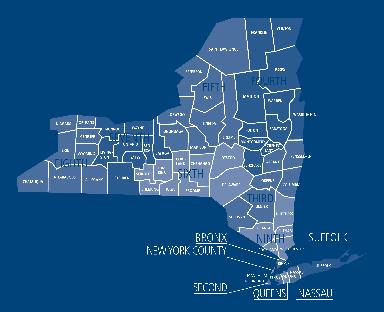
Christina Cocozzo
4 Hamphil Place, Suite 151, Malta, NY 12020
BS, Union College, 1991. DDS, Columbia University College of Dental Medicine, 1995. General Practice Residency, Mountainside Hospital, Montclair, NJ, 1996.
General Dental Practice, Mechanicville, 2009.
Member, Saratoga Dental Society.
Enjoys travel to warm destinations, attending children’s and nephews’ sporting events and holiday decorating.
Spouse: William Moore. Children: Joseph and Cameron.
FIFTH DISTRICT
Christian H. Woodhead
7154 Highbridge Road, Fayetteville, NY 13066
BS, LeMoyne College, 2000. DDS, University at Buffalo School of Dental Medicine, 2004. General Practice Residency, St. Joseph’s Hospital Health Center, Syracuse, NY, 2005. General Dental Practice, Fayetteville.
Member, Academy of General Dentistry, Onondaga County Dental Society. Enjoys golf, history, movies and DIY projects.

The New York State Dental Journal • MARCH 2023 45
Component Presidents 2023
SIXTH DISTRICT
David Salomons
18 Leroy Street, Binghamton, NY 13905
BS, Brandeis University, 1988. DDS, Ohio State University School of Dental Medicine, 1992. General Dental Practice, Binghamton, 1992.
Member, Academy of General Dentistry, Academy of Cosmetic Dentistry. Past President, Broome County Dental Society.

Enjoys soccer, golf, travel and cooking
Spouse: Linda. Children: Noah, Brian, Eric
SEVENTH DISTRICT
Sean McLaren
522 East Moreno Drive, Rochester, NY 14626
BS, Canisius College, 1996. DDS, University at Buffalo School of Dental Medicine, 2001. MBA, University of Rochester, 2022. General Practice Residency, University of Rochester, 2003. Certificate in Pediatric Dentistry, Eastman Institute for Oral Health, 2006. Associate Professor of Dentistry and Pediatrics, University of Rochester Golisano Children’s Hospital. Staff Dentist, St. Joseph’s Hospital, Syracuse. Medical Director, Chief Officer: Quality, Compliance and Safety, University of Rochester Eastman Institute for Oral Health.
Fellow, American Academy of Pediatric Dentistry. Chair, NYSDA Council on Dental Health Planning and Hospital Dentistry. Enjoys running and activities with his children.


Spouse: Andrea. Children: Lauren and Adam.
EIGHTH DISTRICT
Joshua T. Hutter

237 Main Street, #1206, Buffalo, NY 14203
BS, Canisius College, 2001. DDS, University at Buffalo School of Dental Medicine, 2005. General Practice Residency, Northwestern Memorial Hospital, Chicago, IL, 2006. Volunteer Clinical Instructor, University at Buffalo School of Dental Medicine.
Seneca Nation Health System, 2021.
Fellow, International College of Dentists. Alternate Delegate, American Dental Association House. Delegate, NYSDA House. Past President, Executive Council of UB School of Dental Medicine, Eighth District Dental Society Foundation, Erie County Dental Society.
Enjoys travel, hockey, dogs, bourbon tasting and cheering the Buffalo Bills.
NINTH DISTRICT
Daniel C. Doyle
172 Route 311, Carmel, NY 10512
DMD, Farleigh Dickinson University, 1980. General Practice, Carmel, 1980.
Volunteer, Donated Dental Services. President, Putnam County Board of Health. Past President, Putnam County Dental Society. Enjoys golf, softball, hunting and fishing.
Spouse: Karen. Children: Dennis, Patrick, Ryan, Matthew and 5 grandchildren.
46 MARCH 2023 • The New York State Dental Journal
NASSAU COUNTY
Stephen Akseizer
43 Market Drive, Syosset, NY 11791
BA, New York University, 1964. DDS, New York University College of Dentistry, 1968. Retired from General Practice, 2018.
Diplomate, Academy of Dentistry International, International Congress of Oral Implantologists. Fellow, American College of Dentists, American Academy of Implant Dentistry, Academy of Laser Dentistry, American Academy of Cosmetic Dentistry, American Academy of Dental Sleep Medicine, Pierre Fauchard Academy. Trustee, New York State Academy of General Dentistry. Member, NYSDA Information Technology Committee. Delegate, American Dental Association, New York State Dental Association. Past President, New York State Academy of General Dentistry.
Enjoys gardening, travel and computers.
Spouse: Diane. Children: David, Jeffrey, Paul and Michael. 5 grandchildren.
QUEENS COUNTY Arthur J. Feigenbaum

108-20 71st Avenue, Forest Hills, NY 11375
BS, State University of New York at Stony Brook, 1975. DMD, Tufts University School of Dental Medicine, 1978.
Director of Dental Sleep Medicine, ProHealth Dental and Dental Sleep Center of Long Island, Commack.

Diplomate, American Board of Dental Sleep Medicine. Chair, Annual Meeting Committee, American Academy of Dental Sleep Medicine.
Enjoys sports, travel, finance.
Daughter: Emily.
SUFFOLK COUNTY
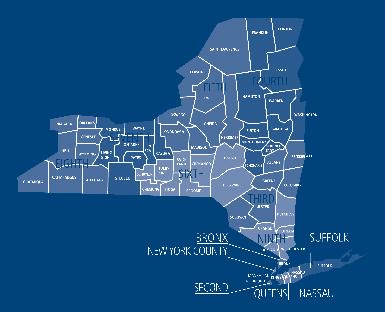
Radha Sachdeva-Munk

203 Smithtown Blvd., Nesconset, NY 11767
BA, University at Buffalo. DMD, University at Buffalo School of Dental Medicine, 1997. General Practice Residency, Mt. Sinai Queens General Hospital, 1998. Associate Professor, University of Rochester. Clinical Attending, Residency Committee and Board of Directors, St. Charles Hospital. Attending, Mather Hospital. General Practice, Smithtown, 1997.
Member, Suffolk County Dental Society Council on Governmental Affairs.
Enjoys skiing, horseback riding, reading and attending children’s sporting events.
Spouse: Henry Coleman. Children: Brian, Dhivya, Rajan, Anya, Kirin.
BRONX COUNTY Keith S. Margulis
North Central Bronx Hospital, 3424 Kossuth Ave, #2A, Bronx, NY 10467
BS, University of Missouri, Kansas City, 2002. DDS, University of Missouri, Kansas City, 2003. MPH, University of Massachusetts, Amherst, 2013. General Practice Residency, New York Medical College, 2004. AEGD, Lutheran Medical Center, 2005. Pediatric Dentistry, Jacobi Medical Center, 2007. Clinical Associate Professor, Albert Einstein College of Medicine.
Pediatric Dentistry, NYC Health + Hospitals/Jacobi/North Central Bronx, 2009.
Diplomate, American Board of Pediatric Dentistry. Member, American Academy of Pediatric Dentistry, American Association of Public Health Dentistry. Member, NYSDA Council on Dental Benefit Programs. Past Chair, NYSDA Council on Dental Education and Licensure.

Enjoys travel, camping, dog training, scuba diving, geocaching, cruising, Disney.
Spouse: Ashley. Child: Emery.
The New York State Dental Journal • MARCH 2023 47
FOR SALE
MANHATTAN: Madison Avenue practice for sale. Long-established FFS general practice for sale. Great Midtown location on Madison Ave. Updated office, 6 ops, fully computerized, digital X-rays. Grossing $1.1M. Please contact for details: hkalts@verizon.net.
WATERTOWN: General dental practice for sale. Grossing approximately $1.1M. Located north of Syracuse in Watertown close to Thousand Islands. Practice has 9 operatories with digital X-ray, CBCT, 3D printing and CEREC. Real estate also available. For more information, please contact Sean Hudson by phone: (585) 690-6858; or email: sean@hudsontransitions.com.
UPSTATE: Charming, long-established, quality, general practice located in gorgeous upstate NY. Turnkey opportunity has it all. Revenue near $1M. Low overhead, brand new equipment including 2 Belmont chairs, NV laser, Dentrix/Dexus technology throughout. Steady stream of new patients, robust hygiene department and prime location on busy main street. Seller refers out most specialty services, providing additional revenue potential for buyer keeping these services in-house. Standalone, 2,170-square-foot beautiful facility feels
Online Rates for 60-day posting of 150 words or less — can include photos/images online: Members: $200. Non-Members: $300. Corporate/Business Ads: $400. Classifieds will also appear in print during months when Journal is mailed: Jan, March and July.
extra spacious with high ceilings and large windows. Four ops with room to expand 1 more if wanted. Additional 1,120 square feet of space has separate entrance and could be turned into dental lab, space for dental specialist or anything else. Plenty of onsite parking. Real estate for sale or lease. Flexible post-transition options available. Don’t miss this exceptional opportunity. Contact Catherine Etters at Legacy Practice Transitions for details: Catherine@LegacyPracticeTransitions.com or (610) 520-9677.
BRONX: Well set up, beautiful dental office for sale in heavily populated area of Bronx. 3 operatories, sterilization room, lab, dark room, reception area and private room. Digital X-ray, computer and equipment all in good running condition. Contact: (718) 379-4800; or email: singhdds@optimum.net.
Oral & Maxillofacial Surgeon
Woodhull Medical and Mental Health Center, a Division of NYC H+H and affiliate of NYU Grossman School of Medicine invites applications for part-time faculty in Division of Oral & Maxillofacial Surgery.
Responsibilities include resident education, research and service. Position entails resident supervision in outpatient clinic and operating room. Seeking individual with commitment to academia, teaching, research and scholarly activity. Salary commensurate with qualifications and experience. Candidate must have DDS or DMD degree from CODA-accredited dental school, eligible for or hold board certification by ABOMS.
Candidates must be able to obtain licensure for clinical practice in NY state or be licensed in NY state. NYU offers stimulating work environment. Some available benefits include:
· One week paid CME
· 24 vacation days (prorated)
· Full benefits including Medical, Dental, Prescription, Disability
· 403B/457 participation
· NYU tuition remission for you and/or your children
For immediate consideration, send CV and letter of interest to: Samantha.deburra@nyulangone.org or mail to: Dr. Earl Clarkson, Chairman, Woodhull Medical Center, 760 Broadway, Brooklyn, NY 11206.
NYU Langone Health is equal opportunity and affirmative action employer committed to diversity and inclusion in all aspects of recruiting and employment. All qualified individuals are encouraged to apply and will receive consideration without regard to race, color, gender, gender identity or expression, sex, sexual orientation, transgender status, gender dysphoria, national origin, age, religion, disability, military and veteran status, marital or parental status, citizenship status, genetic information or any other factor which cannot lawfully be used as a basis for an employment decision. We require applications to be completed online.

BROOKLYN: State-of-the-art dental office for sale. Fantastic, rare opportunity. Fully equipped, wellestablished, family practice with 3 ops, private office, reception area and large waiting room. Prime, groundfloor, street-access location in heart of Brooklyn (Park Slope/Kensington). Long-time building tenant with amendable property management. Contact for details: (516) 859-1463; or email: izdds@aol.com.
ALBANY COUNTY: Bethlehem. Growing community close to downtown Albany on bus line, near major highways leading to NYC. Modern-feel office with four ops, Dentrix Ascend, Dexis, pan, Diode laser and more. Two full-time hygienists, along with valued team working 4-days/week with systems in place and excellent collection policies. No HMOs or state insurance. Excellent opportunity for any dental entrepreneur. For details contact Dental Practice Transitions Consultant Donna Bambrick by email: donna.bambrick@henryschein.com; or call: (315) 430-0643. #NY2712.
HAMPTONS: Well-established FFS endodontic practice. $432K in collections. Practice asking price $300K. 783-square-foot real estate asking price $500K. For details contact Dental Practice Transitions Consultant Chris Regnier at (631) 766-4501; or email: chris.regnier@henryschein.com. #NY3056.
WESTERN NEW YORK: Very attractive and wellestablished endodontic practice. Features 3 modern, well-designed operatories, sterilization center and patient workflow with great function, 3D and digital technologies. Growing PPO practice located in highly desirable area with off-street parking surrounded by all local amenities. Highly profitable with low overhead and skilled team to support patients and transition. To discuss details, contact Dental Practice Transitions Consultant Brian Whalen at (716) 913-2632; or email: brian.whalen@henryschein.com. #NY3042.
SYRACUSE SUBURBS: General practice conveniently located off main road in Liverpool. Open 2.5 days/week with 4 days of hygiene. Healthy patient base with 50% commercial insurance, 20% self-pay and 30% state insurance. Located in small medical building with 4 ops in second-floor rental space with plenty of parking. Grossing $608K with room to grow with help of longstanding staff. For details contact Henry Schein Dental Practice Transitions Consultant Donna Bambrick at (315) 430-0643; or email: donna.bambrick@henryschein.com. #NY291.
ROCHESTER: Great opportunity near hospital. Four large ops, great patient base and 6.5 days of hygiene. Refers out all endo, oral surgery, perio, ortho and implants. Revenue average $450K. One doctor will stay on for transition if needed. Located in busy medical park. Participation in insurance is 80% with some state insurance. Reasonably priced. Utilizing Softdent. For details contact Dental Practice Transitions Consultant Donna Bambrick by email: donna.bambrick@henryschein.com; or call (315) 430-0643. #NY3080.
CLASSIFIED I N F O R M A T I O N
CLASSIFIEDS
48 MARCH 2023 The New York State Dental Journal
TOMPKINS COUNTY: Well-established, highquality general practice available to transition to new owner or stay on as part of team. Located in Ithaca suburb, this beautiful standalone, 15-year-old building of 2,544 square feet has five ops, digital X-rays, utilizes Eaglesoft software and completely paperless. Revenue over $700K. One FT and one PT Hygienist. Real estate also for sale. Growing patient base, practice draws increasing number of new patients with strong mixture of FFS. Great opportunity with doctor willing to stay on as part-time associate. For details contact Dental Practice Transitions Consultant Donna Bambrick by email: donna.bambrick@henryschein.com; or call (315) 430-0643. #NY3071.
EASTERN SUFFOLK COUNTY: Well-established GP family practice. Located in standalone, 1,300-squarefoot building with parking. Includes 2 large operatories and plumbed for third. Grossing $500K. For details contact Dental Practice Transitions Consultant Chris Regnier by email: chris.regnier@henryschein.com; or call (631) 766-4501. #NY3078.
ORANGE COUNTY: GP office currently staffed by full-time veteran associate for sale. Minutes from main highway and features 5 ops, 2,000 square feet utilizing Dentrix software, intraoral camera and imaging system. Grossing $630K. 80% PPO insurances and 20% FFS. For information contact: Dental Practice Transitions Consultant Mike Apalucci at (718) 213-9386; or email: michael.apalucci@henryschein.com. #NY3088.
FLUSHING: Well-established general practice with 4 ops. Fully digital with A-Dec dental chairs, pan/ceph and CEREC. Room to grow with specialties. For details contact Henry Schein Dental Practice Transitions Consultant Chris Regnier by email: chris.regnier@henryschein.com; or call (631) 766-4501. #NY3091.
MIDTOWN MANHATTAN: Beautifully designed 4-op private general practice grossing just over $1M. 2,000-square-foot paperless office running Dentrix and Dexis software on 7 brand-new networked computers. Full digital systems, including AC, COVID special air-filtration system, intraoral camera, imaging system and CariVu. Strong hygiene and dedicated staff. Seller will stay on to support during transition. Contact Dental Practice Transition Consultant Mike Apalucci at (718) 213-9386; or email: michael.apalucci@henryschein.com. #NY3132.
BROOME COUNTY: Great opportunity to practice in small community. A “steal” at $250K for practice and $100K for building with two rental apartments and large parking lot with land to add on. Revenue $645K on 4-day workweek. Exceptional practice with committed staff, wonderful equipment, new pan, big windows in each of six 6 operatories. 2,000 loyal active patients and mix of 65% insurance and 35% FFS. Refers out all endo, implants and perio. For details contact Dental Practice Transition Consultant Donna Bambrick by email: donna.bambrick@henryschein.com; or call (315) 430-0643. #NY3137.
NASSAU COUNTY: Well-established pediatric/ortho practice established 24 years. Six treatment rooms and space to add 3 more. 50% FFS and 50% PPO. Fully digital using pan, digital X-rays and iTero scanner. For details contact Dental Practice Transition Consultant Chris Regnier by email: chris.regnier@henryschein.com; or call (631) 766-4501. #NY3138.
FINGER LAKES REGION: Well-established GP family practice with highly motivated seller. Located in standalone 1,350-square-foot building with 5 ops and space to add on. Building available for sale with practice purchase. Full staff, including 2 doctors, each working 2 days/week, and referring out most specialty procedures. 5,500 active patients (<2 years) with healthy new patient flow. Hygiene booked out. Beautiful high-visibility area with top school district. Doctor will stay for transition if necessary. Gross collections just under $700K. For details contact Dental Practice Transition Consultant Donna Bambrick by email: donna.bambrick@henryschein.com; or email: (315) 430-0643. #NY3147.
WHEATFIELD: Niagara County general practice for sale. Profitable, updated, digital practice with mix of 70% PPO and 30% FFS. Three great ops with plenty of room to add fourth. Set in 1,600-square-foot modern building with abundance of off-street parking. Refers out endo, implants, ortho, perio and some oral surgery, which offers great opportunity and upside for new owner. For details contact Dental Practice Transitions Consultant Brian Whalen at (716) 913-2632; or email: Brian.Whalen@henryschein.com. #NY3166.
NORTH SYRACUSE: Small city beauty. General FFS practice with 4 ops in 900 square feet of 2,000-squarefoot commercial professional building. Softdent, 10 new computers, new 2D pano, new sensors, intraoral cameras and new autoclave. 4 days per week with full-time hygienist. 2021 revenue $612K with earnings average of 40%. Real estate also for sale. Open lot parking with the rental bringing in $26K per year. Walking distance of high school and hospital. Not far from major college. Waterway for sports activity close by. For details contact Dental Practice Transitions Consultant Donna Bambrick by email: donna.bambrick@henryschein.com; or call (315) 430-0643. #NY3173.
SYRACUSE: Four-location GP with removable prosthetics lab in one location that takes care of all locations and outside practices. One can be purchased or all four. Practices have 1 or 2 providers with hygienist and supporting staff in leased spaces. Practices are on Dentrix Ascend, with digital equipment. Handicap accessible; plenty of parking. Revenues range from $600K to $1.5M+ with mix of PPO/ FFS. Great opportunity. For details contact Dental Practice Transitions Consultant Donna Bambrick by email: donna.bambrick@henryschein.com; or call (315) 430-0643. #NY3175.
SUFFOLK COUNTY: Beautiful 1,300-squarefoot general practice. 3 fully equipped treatment rooms and plumbed for 5 ops. 20% fee-for-service and 80% PPO. Active patient count 2,109 and only open three days/week. For details contact Dental Practice Transition Consultant Chris Regnier by email: chris.regnier@henryschein.com; or call (631) 766-4501. #NY3098
UPSTATE: Nestled in great family village community. Make offer for well-established Central New York general family practice close to main highways. Located near one of Top 100 Ranked Golf Courses by GolfWeek. 2021 gross collections $544K. Standalone, 1,800-square-foot building for sale with practice purchase. Great curb appeal, with large parking lot. 3 treatment rooms and space to add on. Refers out specialties. Practice utilizes DEXIS digital X-ray, digital panoramic X-ray, brand new patient chairs. High-profit margins. Healthy new patient flow. Contact Dental Practice Transition Consultant Michael Damon at (315) 430-9224; or email: mike.damon@henryschein.com. #NY3235
INDEX TO ADVERTISERS
CLASSIFIEDS
Accounting for Dentistry 11 Choice Transitions 15 DDS Match 33 Epstein Practice Brokers 17 First Republic Bank Cover II Henry Schein 12 MLMIC Cover IV NSS 5 & 22 NYSDA Renewal 19 NYSSOMS Cover III Paragon 34 The Smilist 4 UB Continuing Ed 9 Utica Dental Lab 13 Woodhull OMS Recruitment 48
The New York State Dental Journal ● MARCH 2023 49
BROOKLYN: Highly desirable, fully digital office with 3 ops in 1,400 square feet. Features digital Sirona panographic X-ray, intraoral camera, laser and Dentrix practice management software. Real estate also for sale and includes upstairs rental property with monthly income. Seller will also consider buyerfriendly lease. 22 hours/week and features 60% FFS and 40% out-of-network providers. Seller available to stay as needed. Contact Dental Practice Transitions Consultant Mike Apalucci at (718) 213-9386; or email: michael.apalucci@henryschein.com. #NY3238
NORTH SYRACUSE: General practice in great location. Main road location with 4 ops in leased space of wonderful, small medical building with plenty of parking. MacPractice Software. All digital with great staff. Doctor will stay for one or two days per week. Takes some insurances, excellent potential for growth adding more days. Great patients surrounded by great neighborhoods. Revenue $325K. For details contact Dental Practice Transitions Consultant Donna Bambrick by email: donna.bambrick@henryschein.com; or call (315) 430-0643. #NY3246
WESTCHESTER COUNTY: 1,400-square-foot 3-op practice in prime upscale area. In practice for 68 years (29 years by current owner and 39 by previous owner).
80% PPO and 20% FFS. Near busy intersection with lots of foot traffic and walking distance from major grocery store and schools. Walking distance from Metro North train station, numerous restaurants and park with playground/pool. Very accessible to public transportation in all directions. Contact Dental Practice Transitions Consultant Chris Regnier at (631) 766-4501; or email: chris.regnier@henryschien.com. #NY3254
ORANGE COUNTY: Served dental needs of continually expanding area and surrounding communities for past 30 years. Located in 1,500-square-foot office building with mixed tenants. 4 fully equipped ops featuring contemporary, up-to-date equipment, including intraoral camera, imaging scanner, Picasso laser unit and Dentrix & Dexis. Skilled and caring team of experienced and very personable dental professionals. Diagnostic, preventive and restorative-driven practice with strong hygiene program. Contact Dental Practice Transitions Consultant Mike Apalucci at (718) 213-9386; or email: michael.apalucci@henryschein.com. #NY3257
WESTCHESTER: Prosthodontist soon retiring and prepared to sell his 50% interest. Looking for buyer who can step in and maintain ongoing dual-office growth. Both offices sit in professional buildings with privately owned condos in great areas of county. Offices each have 5 ops inside 4,100 and 2,850 square feet, respectively. Both locations upgrading and expanding, allowing revenue and procedure growth. Real estate for sale as part of buy-in, or favorable lease will be provided. Seller will stay on as needed. Contact Dental Practice Transitions Consultant Mike Apalucci at (718) 213-9386; or email: michael.apalucci@henryschein.com. #NY3283
ROCHESTER: Family general practice in beautiful suburb with 2021 revenue of $255K+ and growth potential. Seller highly motivated. 1,400-square-foot space with affordable lease, great curb appeal and ample parking. 3 ops with potential 4th plumbed op. Singledoctor practice utilizes digital pano X-ray and Denoptix phosphor plates. Contact Dental Practice Transition Consultant Michael Damon at (315) 430-9224; or email: mike.damon@henryschein.com. #NY3291.
SUFFOLK COUNTY: North Shore. 2 treatment rooms plus one plumbed, with great visibility in desirable community. Dexis digital X-rays, digital pan and Easy Dental software. Open 4.5 days/week; referring out all specialty procedures. Gross revenue of over $483K, with 35% FFS, 65% PPO. Strong hygiene program. Well-trained staff available for transition. Seller open to transition options. Will not last long. Location, location. For more information contact Dental Practice Transitions Consultant Chris Regnier at (631) 766-4501; or email: chris.regnier@henryschien.com. #NY3294.
BROOKLYN: Terrific opportunity in highly desirable area. 65% PPO, 30% FFS and 5% indemnity insurance. Open 6 days/week and has very strong supporting staff. Sellers would like to stay as associates for agreed upon time. For details contact Dental Practice Transition Consultant Chris Regnier by email: chris.regnier@henryschein.com; or call (631) 766-4501. #NY3041.
BROOKLYN: Orthodontist practice in prime location. Four treatment rooms; 100% FFS practice with 940-square-feet in professional building. Doctor in practice 22 years. Equipped with digital sensors and pan/ceph. Tremendous room for growth for doctor willing to work more than 1 day/week. For more information contact Dental Practice Transitions Consultant Chris Regnier at (631) 766-4501; or email: chris.regnier@henryschien.com. #NY3325.
KINGSTON: 3 ops with Carestream software, digital sensors, digital scanner, CEREC mill and pan/ceph with phosphor plates. Doctor refers out most endo, all implant placements and perio. Great staff, including one highly trained in Sleep Study. Building on large lot also for sale. Rental apartments in building bring in extra income. For more information contact Dental Practice Transitions Consultant Chris Regnier at (631) 766-4501; or email: chris.regnier@henryschien.com. #NY3327.
ERIE COUNTY: Great practice with 3 treatment rooms. All digital with collections of $413K. For details contact Dental Practice Transitions Consultant Brian Whalen at (716) 913-2632; or email: brian.whalen@henryschein.com. #NY3366.
QUEENS: Nassau County border. Terrific familyoriented practice for sale. Highly desirable neighborhood of Floral Park, Queens. Located in freestanding building with 1,250 square feet. 3 fully equipped treatment rooms with digital X-rays and utilizing Easy Dental software. Building handicap accessible and offers easy street parking. Diagnostic, preventive
and restorative-driven practice with strong hygiene program. Seller owns building and will provide buyerfriendly lease. Contact Dental Practice Transitions Consultant Mike Apalucci at (718) 213-9386; or email: michael.apalucci@henryschein.com. #NY3370.
FOR RENT
MIDTOWN MANHATTAN: Newly decorated office with windowed operatory for rent FT/PT. Pelton Crane equipment, massage chair, front desk space available; shared private office; concierge; congenial environment. Best location on 46th Street between Madison Avenue and 5th Avenue. Please call or email: (212) 371-1999; karenjtj@aol.com.
MANHATTAN: Grand Central location. Modern dental operatory for rent full time or part time. Prime location in professional building with concierge. Front desk space available. Friendly environment. Please call: (917) 446-4058; or email: dr.bberkowitz28@gmail.com.
WHITE PLAINS: Dental operatory for rent in modern and beautiful 4-chair office with panoramic and Ceph units. Free parking in center of White Plains. Very accessible to public transport (Metro North and buses). Open to rental by Specialist or GP. Rent negotiable. Inquire by email: 21eh1997@gmail.com.
MIDTOWN MANHATTAN: Op for rent at East 56th Street. Beautiful operatory with windows and private office available for rental. Elegant, modern, street level; best location. Please call or email for details. Phone: (917) 721 6825; email: esenayny@gmail.com.
MANHATTAN: Central Park South. Two dental operatories for lease in 4-op oral surgery practice with windows facing Central Park in exclusive medical condominium building. Front desk for two, waiting area, laboratory and bathroom. Option to transition to ownership. Work in pristine office in prime location. Tremendous growth potential. Please inquire by email: nycentralparksouth@gmail.com.
MIDTOWN MANHATTAN: Beautiful dental office with 1-3 operatories available. Located across from MOMA in building with 24-hour doorman. Fully equipped and digital. Inquiries to: drhwass@yahoo.com.
WHITE PLAINS: Modern, state-of-the-art operatories available in large office with reception. Available FT/PT. Turnkey. Rent includes digital radiology with pan, equipment, Nitrous, all disposables. Start-up or phase down. Need a satellite or more space? Upgrade or down size. Contact us at (914) 290-6545; or email: broadwayda@gmail.com.
UPPER EAST SIDE: Operatory for rent in UES (Madison Ave & 60th St.) office. Modern, quiet, boutique private practice. Endodontic microscope, 2 digital scanners, materials, instruments available for rent. Inquiries by text or email: (646) 648-3242; or pyondds@gmail.com.
CLASSIFIEDS
50 MARCH 2023 The New York State Dental Journal
MIDTOWN MANHATTAN: Madison Avenue next to world-renowned St. Patrick’s Cathedral. Beautiful, large, renovated office with in-house, full-service dental lab. Shared front desk space, shared private doctors’ office. Fully equipped with CS-9600 CBCT scanner. Large conference room with presentation dual TV/monitor. Please contact doctor directly at (646) 265-7949.
MIDTOWN MANHATTAN: Central Park South. Ready to use, recently renovated dental operatories/chairs available for rent. Flexible lease terms, i.e., per hour, per day, etc. Great street access with lots of foot traffic. Easy to commute to and from with public transport. Can provide dental assistants, billing services and insurance assistance, etc. if needed. Please call/text (917) 605-9496; or email: doc@centralparkdentalservices.com.
MIDTOWN MANHATTAN: Lexington Avenue and 40th Street. Located on 16th floor with 24/7 access. Modern, state-of-the-art practice has 1 op available in 5-op office with reception. Perfect for startup, GP or specialist. Fully equipped and private office. Please contact (212) 697-3999.
TRIBECA: Dental op with10-foot ceiling available for rent in brand new dental office. State-of-the-art dental chair with curing light, Cavitron, camera and monitor. X-ray machine and TV in op. Dentists will also have access to brand new reception desk, central air, 17-footlong lab area. Inquiries to: patmoez@gmail.com.
MANHATTAN: Upper East Side. 1-2 dental operatories for rent, full or part time. Located on 63rd Street between 2nd and 3rd Avenue. Good for specialist or GPs. Street level, close to R, F, Q, N, 4, 5, 6 subway lines. Digital X-rays. Possible partnership. Please contact us for more information. Email: dr.asphaic@yahoo.com; or (917) 697-6865.
MANHATTAN: Dental op available for rent at 58th Street between Lexington and 3rd. A fully equipped operatory available in newly built, multi-specialty private practice located on 58th Street between Lexington and 3rd Avenue. Available full time or part time. Back office and front desk help available if needed. For more information, please contact us at (212) 838-0840; or email: manager@zarabidental.com.
EQUIPMENT FOR SALE
X-RAY UNITS: Used X-ray units for sale. In excellent condition. If interested, please contact Jeffrey Maloff by email: drjsm4life@gmail.com.
OPPORTUNITIES AVAILABLE
MANHATTAN: As we expand oral and maxillofacial services across Northwell Health, we are seeking Chief of Oral and Maxillofacial Surgery at Lenox Hill Hospital. Exciting position offers opportunity to lead and develop department at LHH, in conjunction with chair and senior vice president for Dental Medicine. Department of Oral and Maxillofacial Surgery at Northwell Health Lenox Hill Hospital provides very best in comprehensive head and neck service in New York metropolitan area. Lenox Hill Hospital, 652-bed, acute care hospital, is located on Manhattan’s Upper East Side. Staple in community for more than 150 years, hospital has earned national reputation for outstanding patient care and innovative medical and surgical treatments. All candidates will receive competitive salaries, comprehensive benefits package and eligibility for tuition reimbursement. Physicians will be employed as members of Northwell Physician Partners, fifth largest medical group in country. Academic appointment to Donald and Barbara Zucker School of Medicine at Hofstra/Northwell is commensurate with credentials and experience. For further details and to apply, please email Office of Physician Recruitment, Northwell Health, OPR@northwell.edu.
SOUTHERN TIER: Excellent associateship position with partnership opportunity (if desired) for the right general dentist. Join well-established FFS group practice in state-of-the-art facility. Modern implant, restorative and endodontic techniques employed using digital imaging, cone beam and digital scanning technology. Great location in growing University community. Planned retirement of current dentist creates immediate patient base. Inquire by email: columbiadentalgrp@gmail.com; or call (607) 765-85413.
CAPITAL DISTRICT: Full-time associateship in busy, 20-operatory practice with two other general dentists, one pediatric dentist, serving 6,000+ patients. Diverse patient pool offers plenty of opportunities to finetune your hand skills while learning more advanced techniques from senior doctors. Located just west of Albany with great salary and benefits, including daily guarantee, 401k with match, profit sharing, disability/life insurance and more. Affordable lifestyle, great outdoors, family friendly, plenty to do. Fully updated practice in gorgeously rehabbed 1860s mansion that blends vintage architecture with modern technology. Big windows, crown molding, fireplace, extravagant chandelier juxtaposed with brand-new A-Dec chairs, cabinetry. Start with bread-and-butter dentistry, then choose to stay in your comfort zone or grow into more specialized procedures. Open to new dentists or more experienced doctors looking for positive change. Choose level of autonomy that makes you comfortable. Learn more about this amazing practice and opportunity. Email: advisor@ada.org.
MANHATTAN: West 57th Street. Retirement-minded dentist with long-established fee-for-service general practice. Seeking associate with practice who wants to grow their nucleus of patients. Three-chair office; good amenities. Helpful staff. Goal is compatible sale and transfer of my practice with lease and equipment. Respond to: dds.midtownwest@gmail.com. `
NEW YORK CITY: Oral & Maxillofacial Surgeon. Woodhull Medical and Mental Health Center, Division of NYC H+H and affiliate of NYU Grossman School of Medicine, invites applications for part-time faculty in Division of Oral & Maxillofacial Surgery.
Responsibilities include resident education, research and service. Position entails resident supervision in outpatient clinic and operating room. Seeking individual with commitment to academia, teaching, research and scholarly activity. Salary commensurate with qualifications and experience. Candidate must have DDS or DMD degree from CODA-accredited dental school, eligible for or hold board certification by ABOMS. Candidates must be able to obtain licensure for clinical practice in NY State or be licensed in NY State.
NYU offers stimulating work environment. Some benefits available to you are: One-week paid CME; 24 vacation days (prorated); full benefits including Medical, Dental, Prescription, Disability; 403B/457 participation and NYU college tuition remission for yourself and/or children. For immediate consideration, send CV and letter of interest by email to: Samantha.deburra@nyulangone.org; or mailed to Dr. Earl Clarkson, Chairman, Woodhull Medical Center, 760 Broadway, Brooklyn, NY 11206.
NYU Langone Health is equal opportunity and affirmative action employer committed to diversity and inclusion in all aspects of recruiting and employment. All qualified individuals are encouraged to apply and will receive consideration without regard to race, color, gender, gender identity or expression, sex, sexual orientation, transgender status, gender dysphoria, national origin, age, religion, disability, military and veteran status, marital or parental status, citizenship status, genetic information or any other factor which cannot lawfully be used as a basis for an employment decision. We require applications to be completed online.
UPSTATE: Fantastic and rare opportunity to join highquality and rapidly growing dental group. Our facilities are modern and state-of-the-art, with new equipment, digital X-rays and paperless charting. Seeking the right dentists to join team as we expand and grow. Firstyear and second-year salary minimum guaranteed with opportunity for earnings well above average. Flexible terms and can be tailored to fit your individual desires if determined to be right fit. Very competitive compensation methodology. Training available for precisionguided dental implant surgery. Very strong mentorship program for new and recent graduates. www.sitwelldental.com. Contact John O’Brien, DDS, by email: jobrien1218@gmail.com; or call (518) 703-5321.
CLASSIFIEDS
The New York State Dental Journal ● MARCH 2023 51
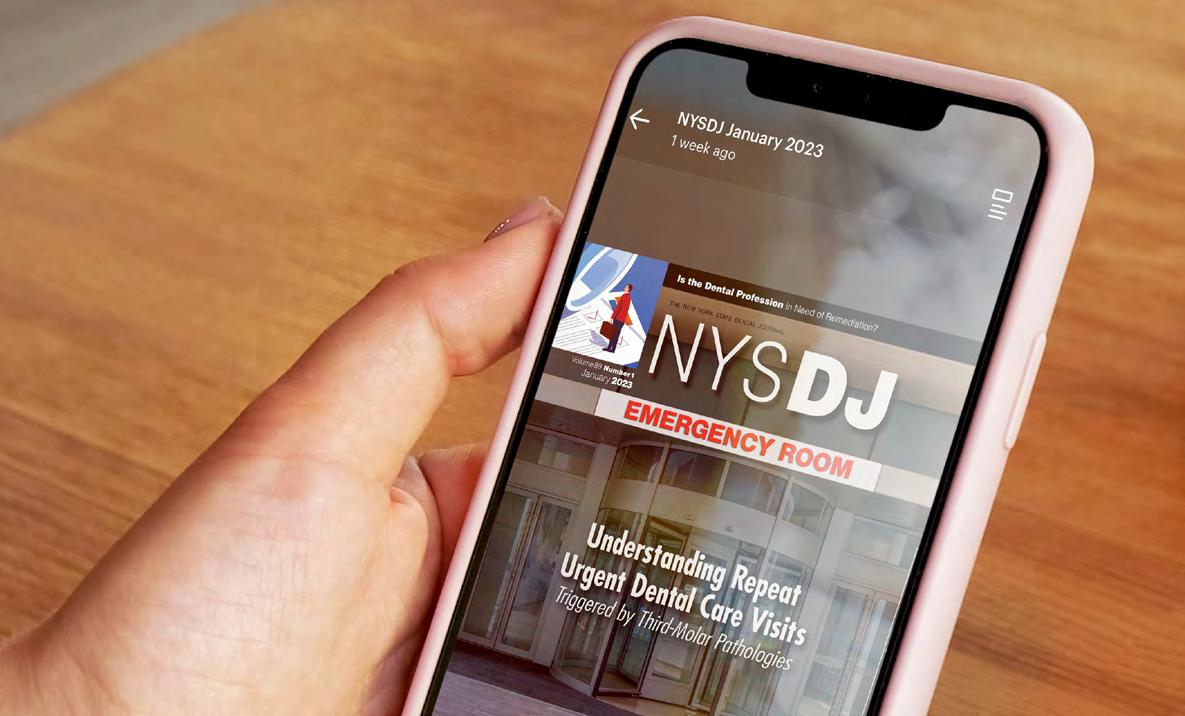











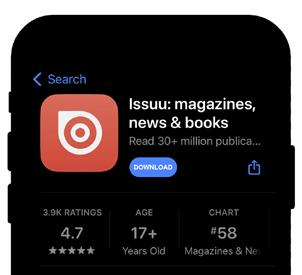
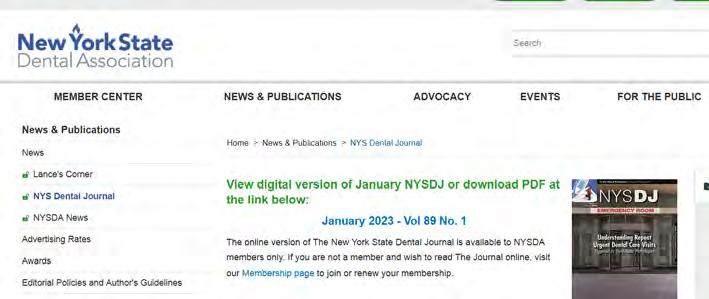
Download Issuu and read with ease on your mobile device How are you viewing the online Journal? Visit your App store and search for Issuu Download the App to your device Because our publications are private, you’ll need to access via the link on our website 1 2 3
When should you consult an oral and maxillofacial surgeon (OMS) about third molars?


Because complications increase dramatically with age, all third molars should be evaluated each year for potential problems. When warranted, they can be removed in the OMS office using safe and appropriate anesthesia. Visit MyOMS.org for more information.

MyOMS.org © 2019 American Association of Oral and Maxillofacial Surgeons (AAOMS). AAOMS_WisdomTeeth_8x10-875in_Message2_2019.indd 1 1/3/19 10:33 PM
localized risk management guidance, claims protection, and underwriting support. Our policyholders enjoy benefits and expertise not found anywhere else — supported by concierge-level service every step of the way.
For dental malpractice insurance in New York, nothing compares to MLMIC.
The NYSDA-MLMIC program provides New York dentists from Buffalo to the Bronx with localized risk management guidance, claims protection, and underwriting support. Our policyholders enjoy benefits and expertise not found anywhere else — supported by concierge-level service every step of the way.
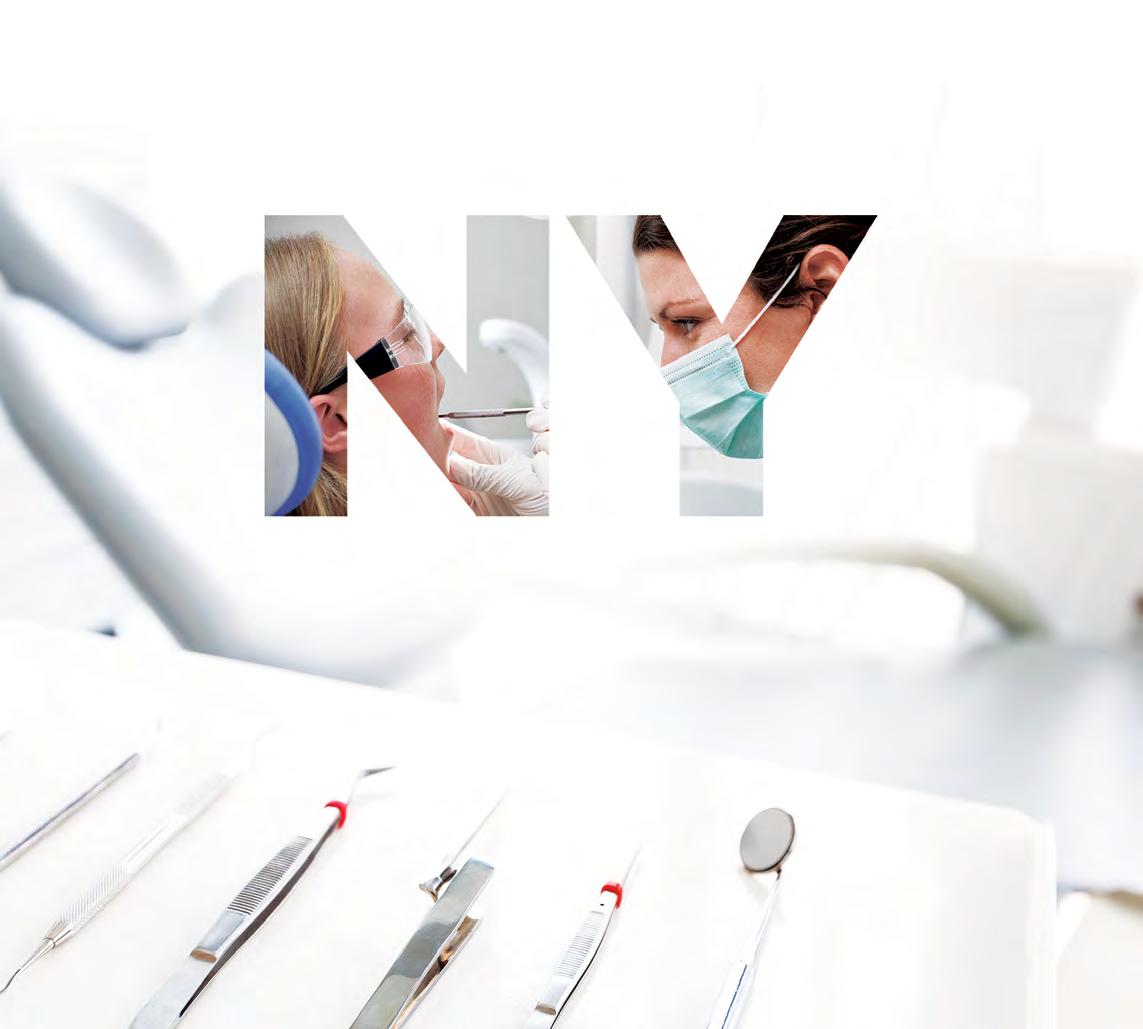
Learn more at MLMIC.com/dental Or, call (888) 392-0638
For dental malpractice insurance in New York, nothing compares to MLMIC.
Learn more at MLMIC.com/NYdental Or, call (888) 392-0638
No one knows better than MLMIC. Choose NY’s #1 dental liability insurance provider.
NYSDA MEMBERS $50 First Year Coverage for New Grads
TODAY
CALL











 D.D.S., J.D.
D.D.S., J.D.















































































































